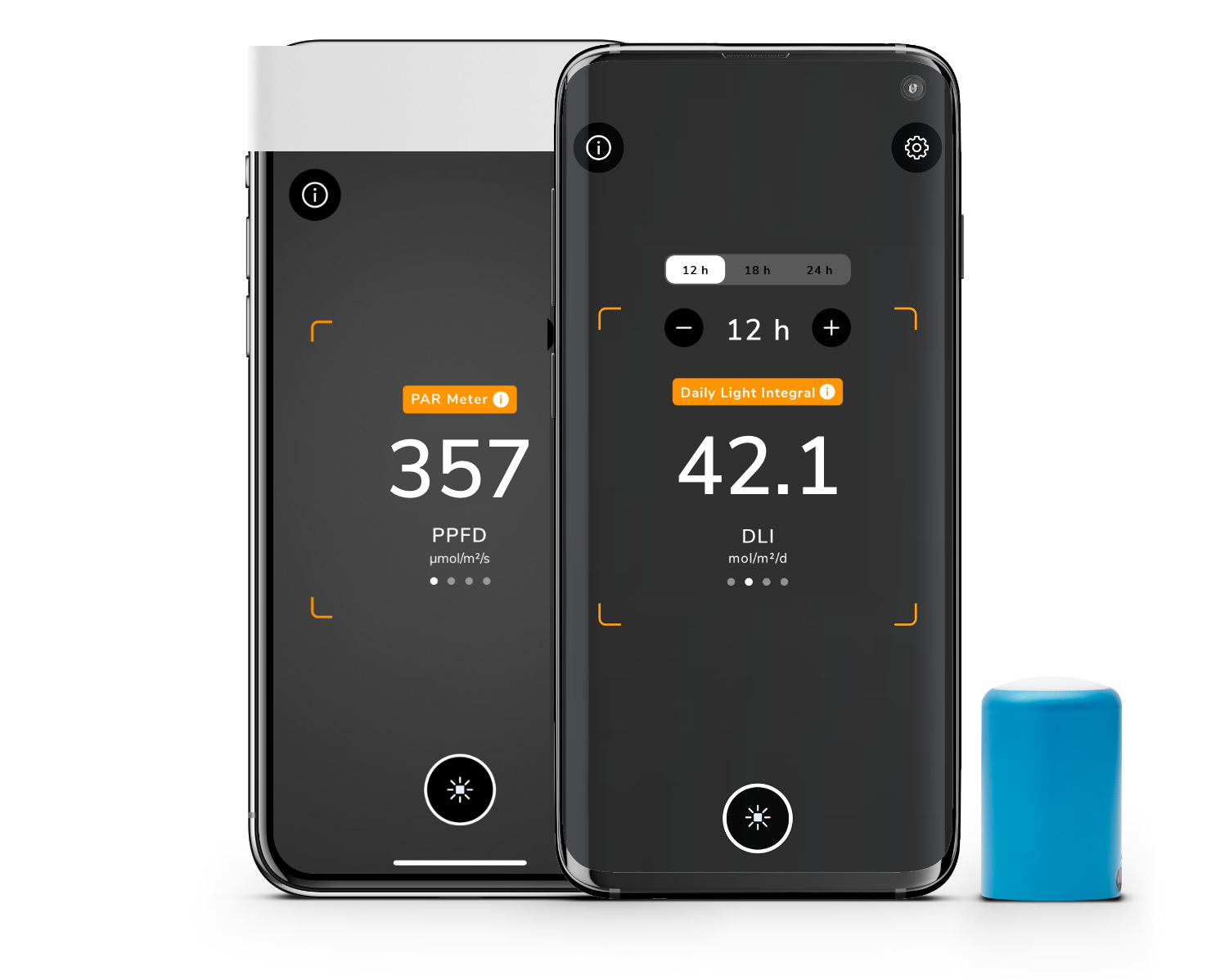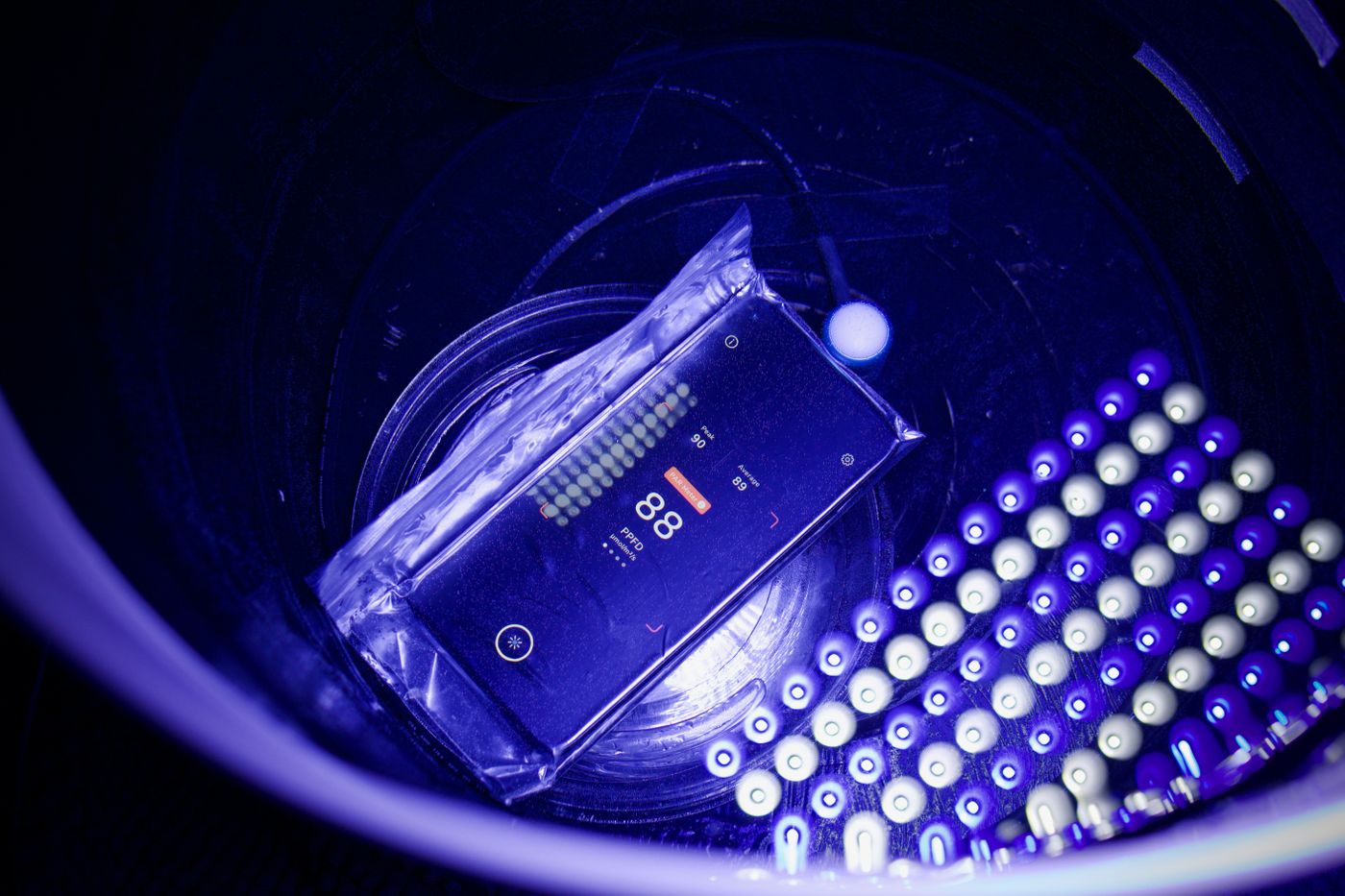
Auto-Translate
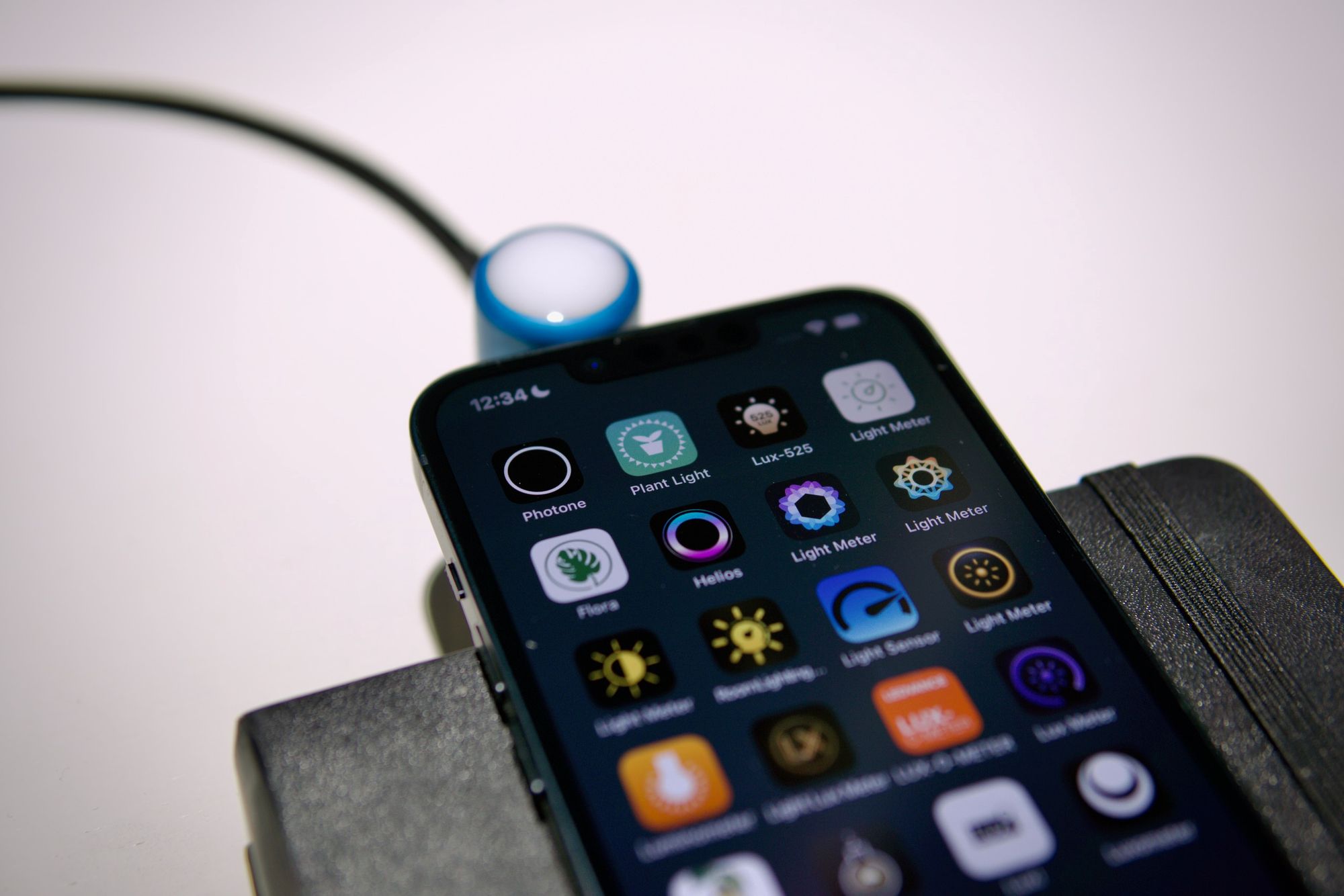
Light is such an important factor for plant growth and wondering about your plant lighting can certainly keep you up at night. Luckily enough there is a simple solution that does not cost an arm and a leg: A light meter app.
Within this test, we covered all relevant light meter apps for plants on both iOS and Android that are available right now. Read along to identify the light meter app that is right for you!
Contents
Why You Need a Light Meter
You want luscious and healthy plants. Apart from water, light is the most influential factor for plant growth and the one that is most commonly handled incorrectly.
Achieving Adequate Plant Lighting
Plant lighting requirements are well understood by plant scientists across the world today. There are different measures of light such as lux, lumen, foot-candles, PPF, PPFD, and more. As for plants, the important factor to measure is PPFD within the PAR spectrum. The PAR spectrum contains the light that is actually used for plant photosynthesis. Measuring illuminance in lux or foot-candle won’t get you there as those measurements are representative for the human eye and not for plants.
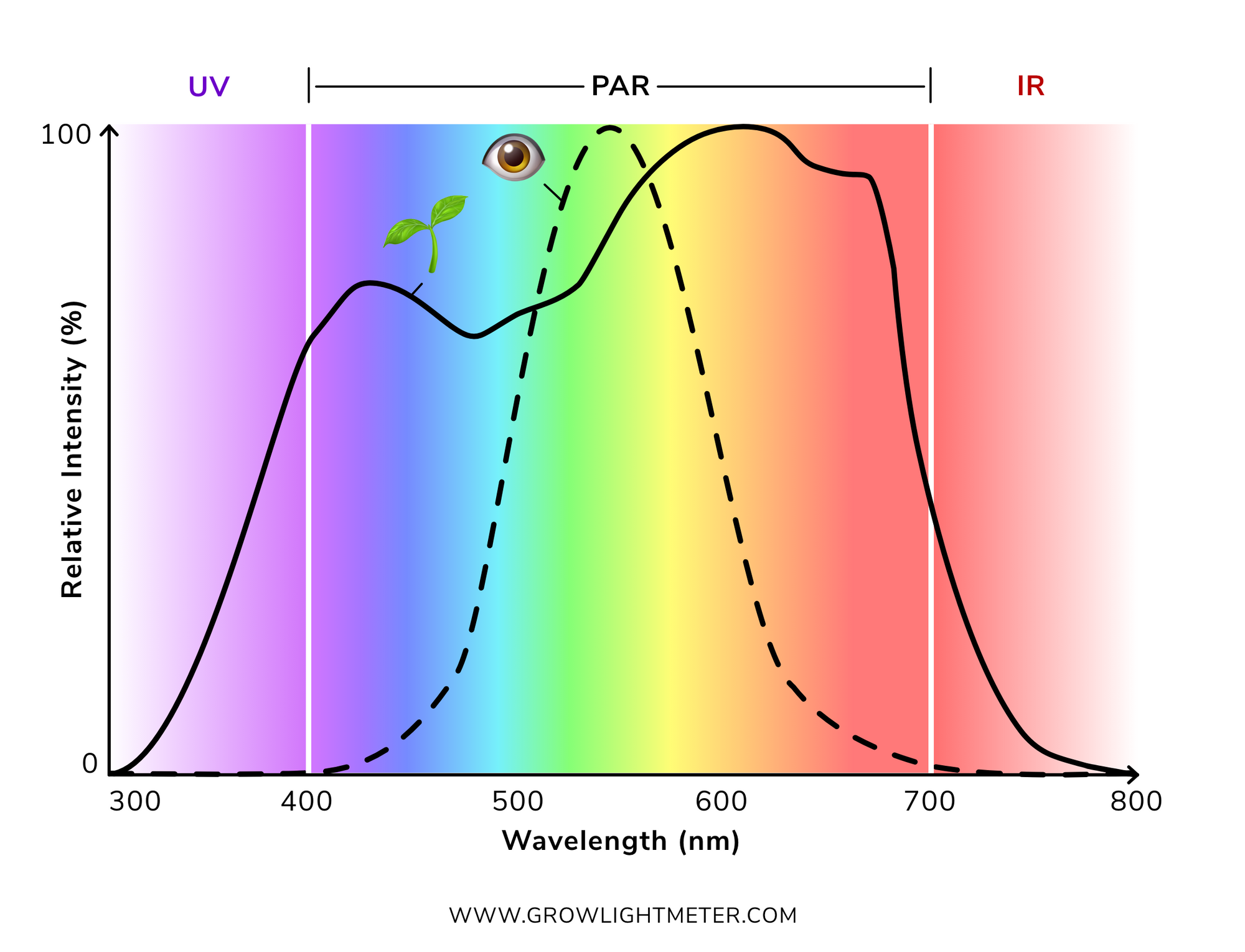
If you want a deeper explanation of illuminance and PAR, we recommend our article on exactly that and the article about the daily light integral (DLI) to learn more about plant lighting.
Light Meter Knowledge: A Quick Introduction
A light meter is measuring the amount of light reaching a surface such as your plants’ leaves. It is using specialized photodetectors that capture light particles (photons) within a specified spectrum to measure illuminance or PAR. In order to measure absolute light intensities accurately, the light meter must be calibrated to a trustworthy reference. Fortunately enough, you shouldn’t have to worry about this as this is usually done at the factory. Cheap and inadequate light meters bring problems such as inaccurate factory calibrations, nonlinear behavior, bad repeatability, or even peaking measurements when the light is just too bright. To spare you all of this, we’ve expertly tested many light meters in our lab and share the results within this article.
Bad Light Meters Hurt Your Plants, Your Wallet, Or Both
Lighting is such an important and decisive factor between a plant that thrives and a plant that dies off. Some plants are more fragile than others, however, whenever artificial lighting is involved, using your grow light wrong may not only hurt your plants but your wallet as well. Gauging the light correctly is crucial and an inaccurate light meter can be extremely dangerous. So keep this in mind when tinkering with light meters for your plant lighting.
What Makes a Good Plant Light Meter
As a baseline for our test, we first need to identify what makes a good plant light meter – or in this case specifically: A good plant light meter app. For amateurs and professional growers alike, we identified the following criteria:
- The plant light meter shall be easy-to-use
- The plant light meter shall measure PAR as PPFD
- The plant light meter shall be accurate and precise
- The plant light meter shall be cost-efficient
- The plant light meter shall be well maintained (supporting the latest devices, offering support, etc.)
We’ll cover each of these criteria in our subsequent test and recommendation to gain you the peace of mind needed when it comes to choosing your light meter app.
iOS Plant Light Meter App Recommendation
A quick search on the App Store reveals many light meter apps. Most of them are targeted to be used in photography while some of them act as a simple illuminance meter. As we all know by now, we want to measure PAR / PPFD for our plants and there is only one app able to measure PAR / PPFD, so we’ve included other illuminance-based plant light meter apps from the App Store into our comparison as well.
iOS App Accuracy Comparison
As we are first and foremost comparing light meters, they need to measure accurately. Our tests revealed that only two apps do so and that's why they're at the top of our recommendations.
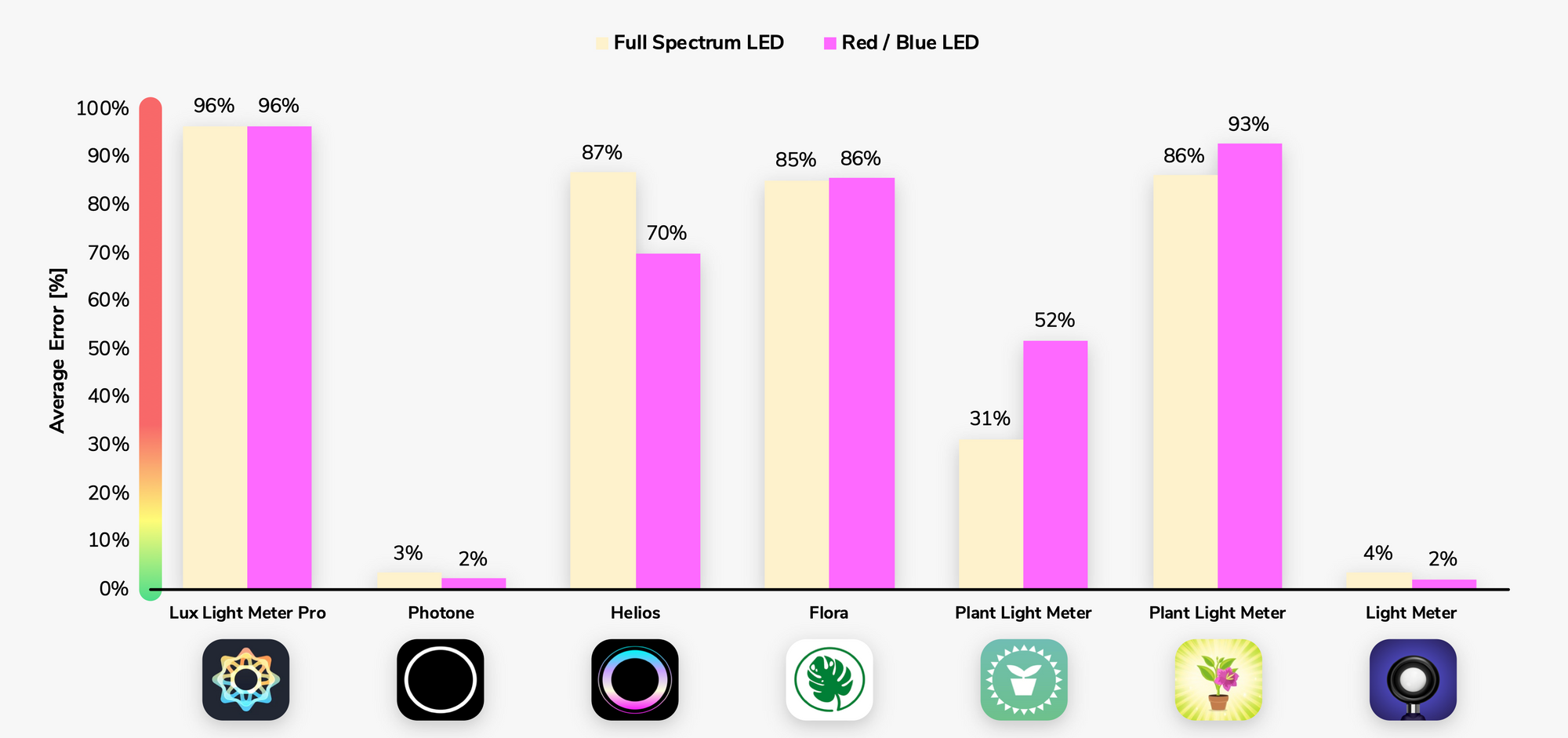
A small error is to be expected as no light meter exactly measures the same, but any error exceeding 10% becomes noteworthy whereas errors upwards of 30% even become dangerously critical. You can find the detailed measurements and how we took them towards the end of this article.
Recommended for Everyone: Photone - Grow Light Meter
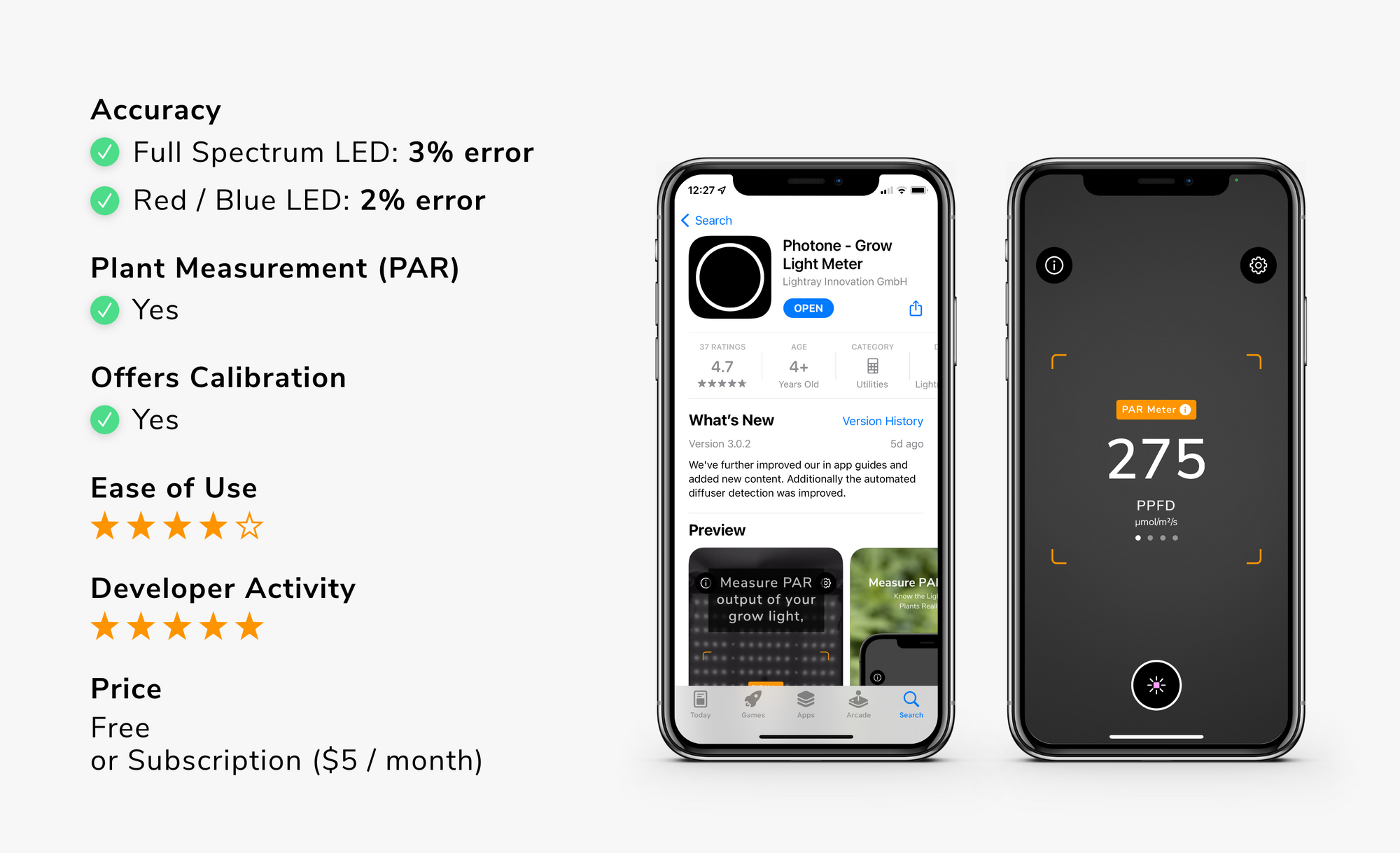
The Photone - Grow Light Meter is our own app and we don't want to advertise you anything without our full backing. We knew that Photone is the only plant light meter app on the App Store that is measuring even close to accurate – yet still we were blown away by the inaccuracy of all the other plant lighting apps. Photone also includes helpful guides and a calculator for cannabis, houseplants, and fruits and vegetables to assist you with your grow lighting decisions. The app can be used for free and also includes additional measurements, content, and fast 24 hour support with the optional Pro subscription.
Tolerable for Beginners: Plant Light Meter

The Plant Light Meter app is well-made and backed by a professional and active developer. It also includes a database of common houseplants and their lighting requirements that may be especially useful for beginners. We want to recommend this app but use it for grow lighting decisions with extreme caution.
As a side note on measuring, it is the only app that measures reflected light instead of incident light and outputs the result as a range. We therefore took the average of the displayed value as the measurement for the comparison.
Recommended, but Not for Plants: Light Meter LM-3000
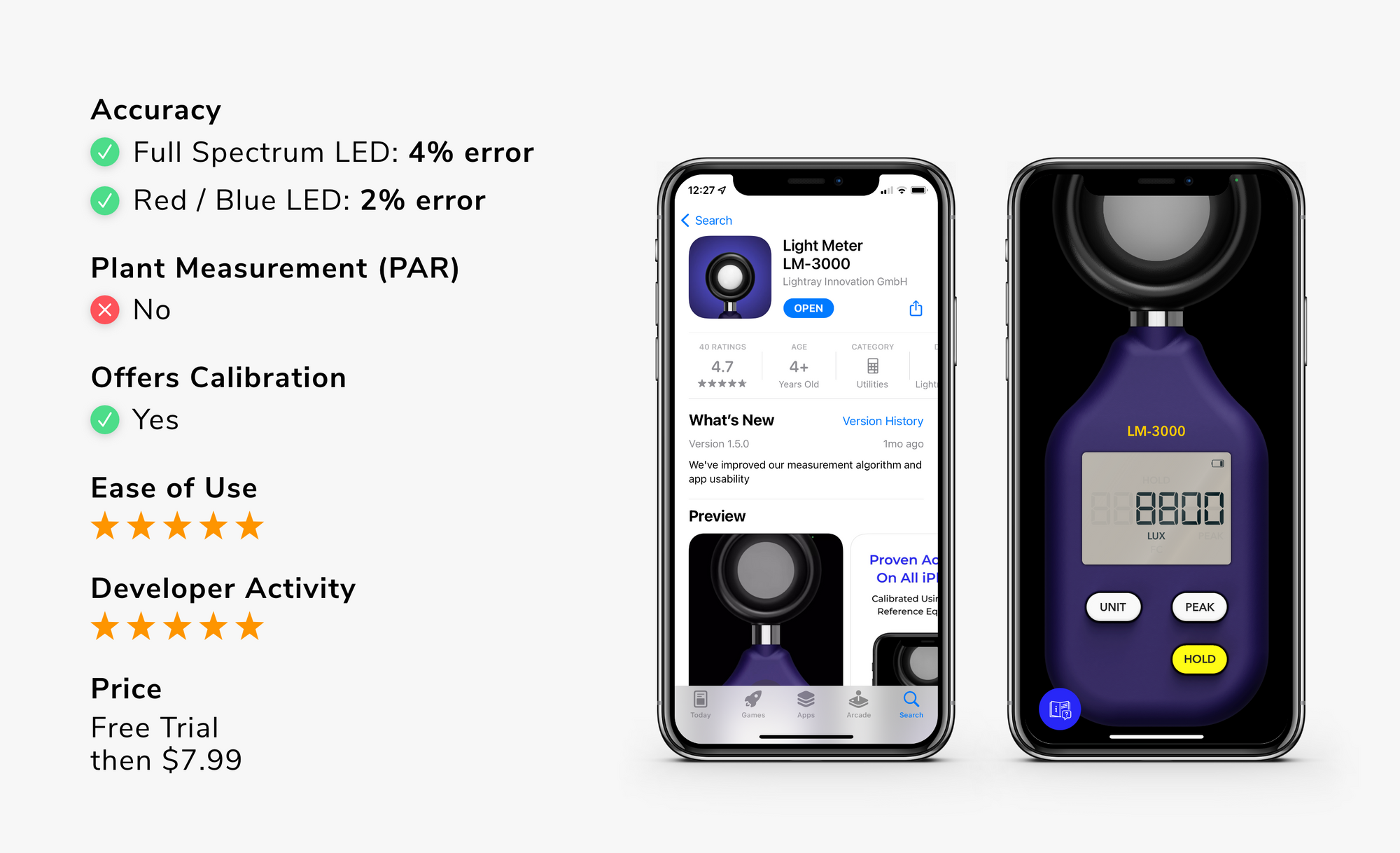
The Light Meter LM-3000 is made by us as well and uses the same measurement technology as Photone – no surprise that it is just as accurate. However, it serves as a general-purpose lux meter and is not made specifically for plants. If you only need a reliable and trustworthy lux and foot-candle measurement, the LM-3000 is the way to go.
Not Recommended: Lux Light Meter Pro
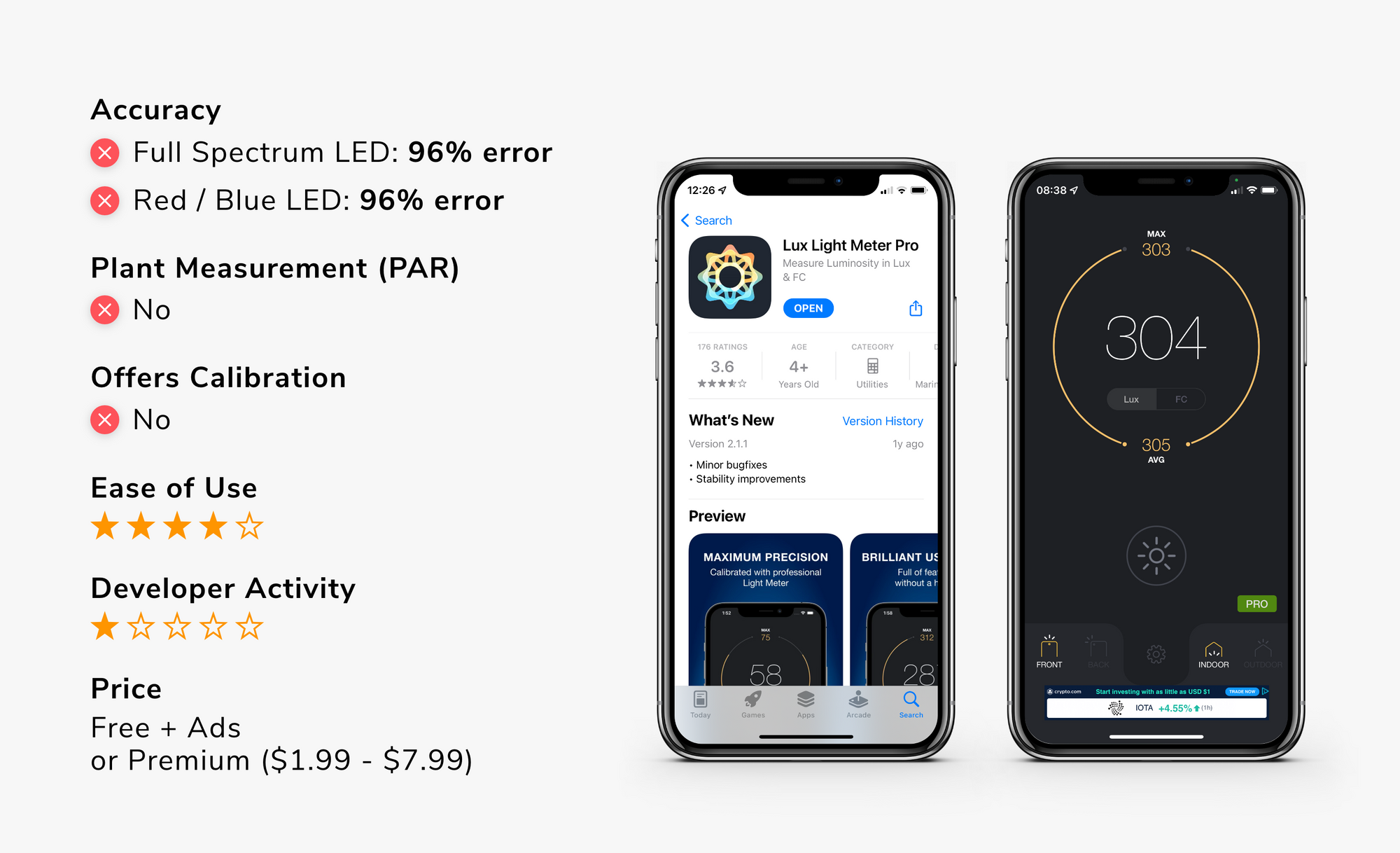
The Lux Light Meter Pro app developed by Marina Polyanskaya seems to be widely used and ranks first in the App Store search. Using it has a learning curve attached, but once you get the hang of it, you can operate the app somewhat reliably. However, the app is infrequently maintained, pretty pricey (unless you like ads), and most importantly: Very inaccurate.
Not Recommended: Plant Light Meter LUX & Care
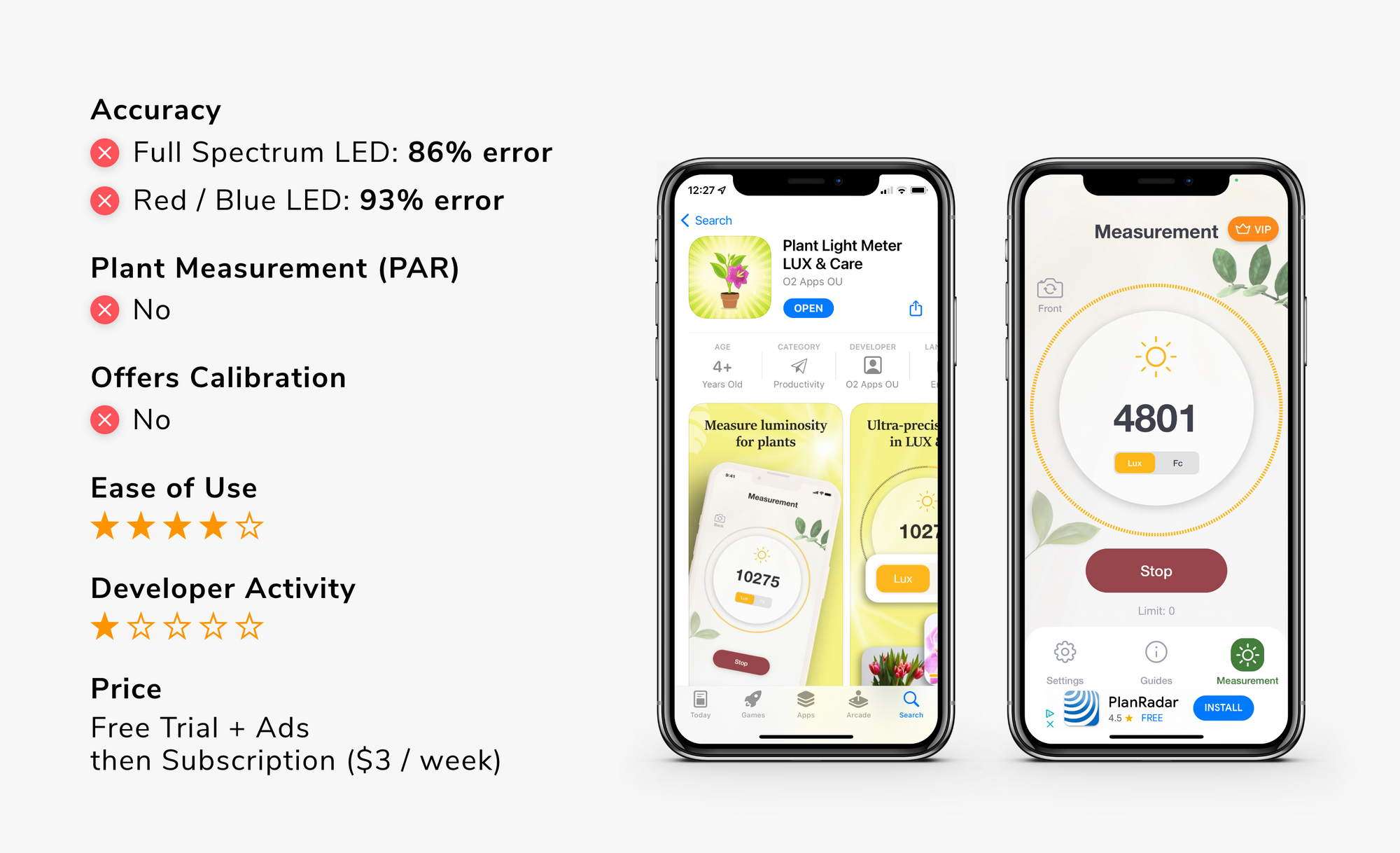
Plant Light Meter LUX & Care is a new app that wasn't available when we took this test in 2021. The user interface looks appealing and the app is very easy to use. It offers you a free trial (whilst also showing ads) to take three measurements. After that, you need to pay a hefty fee of $3 as a weekly subscription. As with the others, the Plant Light Meter LUX & Care isn't accurate enough to serve as a plant light meter.
Not Recommended: The Helios
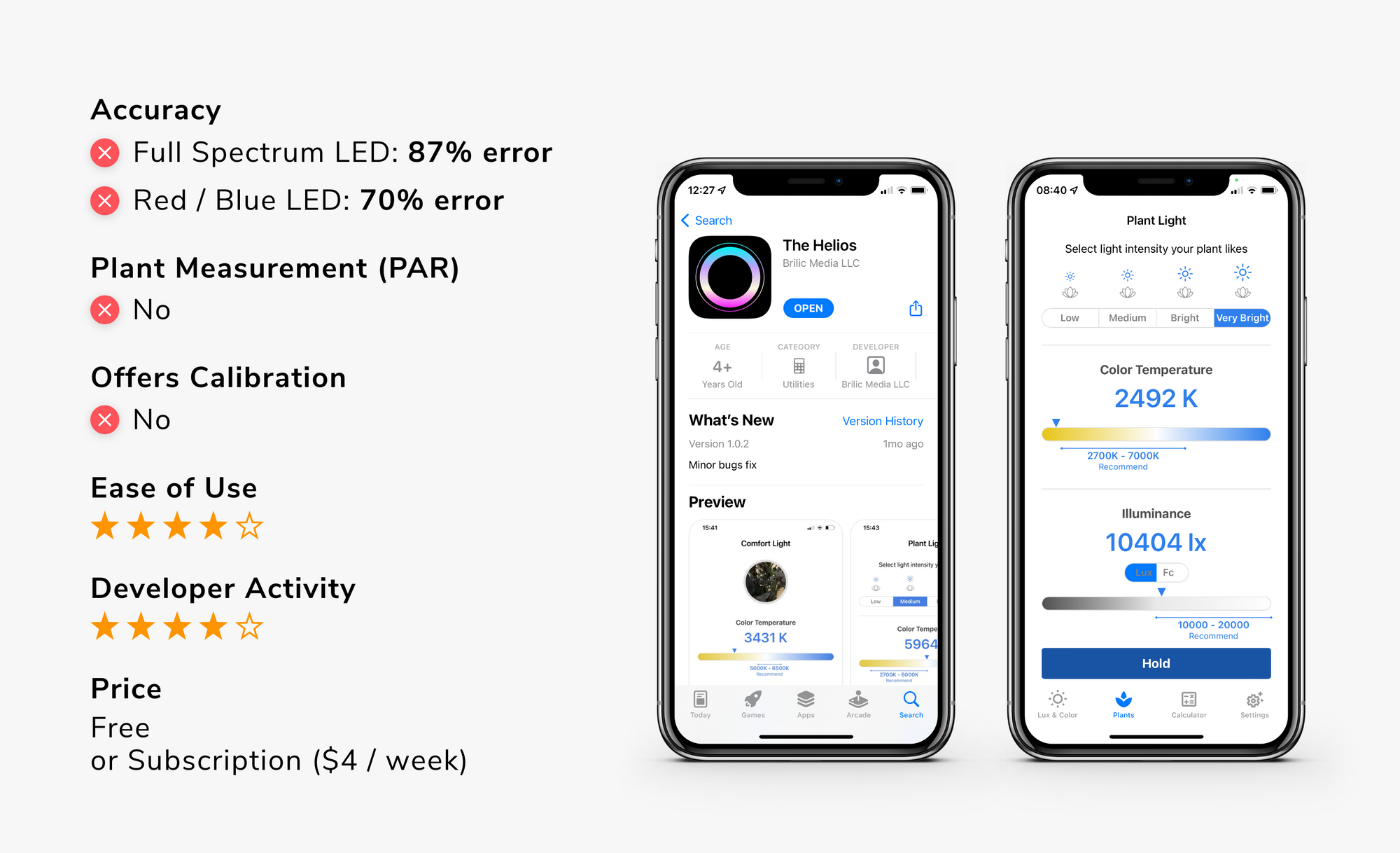
The Helios is another new app just released in 2022. The app looks promising and well-made with a simple and intuitive user interface and an active developer that is frequently publishing new releases. Still, it isn't accurate and also pretty expensive if you opt for the weekly subscription.
Not Recommended: Flora - Houseplant Care

The Flora - Houseplant Care app feels different (and not in a good way) as it is just loading a website that comes with many quirks and issues. The UI is very basic but also pretty nested. Even though the app is free, following its lighting advice can cost you your plants and we don't recommend doing so.
Other Light Meter Apps
There are other light meter apps that claim to measure illuminance (lux / fc) available in the App Store. We took a look at "Luminous Meter", "Lux Meter - light measurement tool", "Light Meter - measure luminosity", "Galactica Luxmeter", "Light Lux Meter", "Whitegoods Lightmeter", "Nurus Light Wellness", and "Light Meter +". However, none of these were even remotely usable as a light meter and we therefore didn't include them in this test. In last year's test, we also included "LUX Light Meter FREE" that didn't make it into our selection this time. We don't recommend using any of the aforementioned apps.
Android Plant Light Meter App Recommendation
The Google Play Store hosts many light meter apps and also many of them specifically made for plants. Measuring an illuminance is easy on Android as almost any device has a built-in ambient light sensor that can be accessed by any developer. However, as we know, we want to measure PAR / PPFD for our plants and there are only a few apps able to measure (or convert to) PAR / PPFD, so we’ve included other illuminance-based plant light meter apps from the Play Store into our comparison as well.
Android App Accuracy Comparison
As we are first and foremost comparing light meters, they need to measure accurately. Our tests revealed that most apps are comparingly accurate when it comes to "white" full spectrum lighting, but heavily differ when measuring "blurple" red / blue LED light. The accuracy of all illuminance-based plant light meter apps comes down to the built-in ambient light sensor that proves fairly accurate on our Samsung Galaxy S10 test device. When converting this illuminance measurement to PAR however, the apps differ wildly!
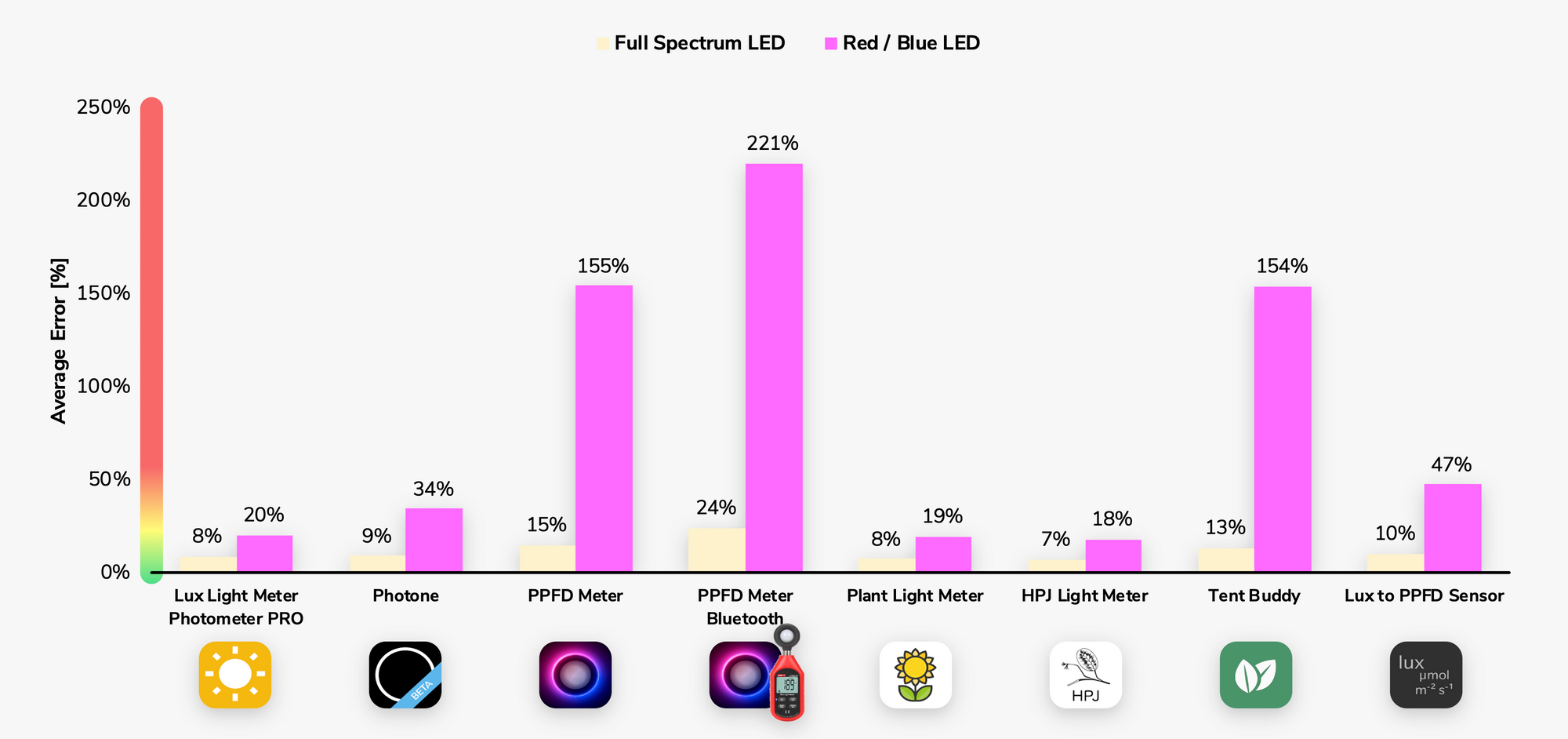
A small error is to be expected as no light meter exactly measures the same, but any error exceeding 10% becomes noteworthy whereas errors upwards of 30% even become dangerously critical in some scenarios. You can find the detailed measurements and how we took them towards the end of this article.
Recommended for Everyone: Photone - Grow Light Meter for Plants
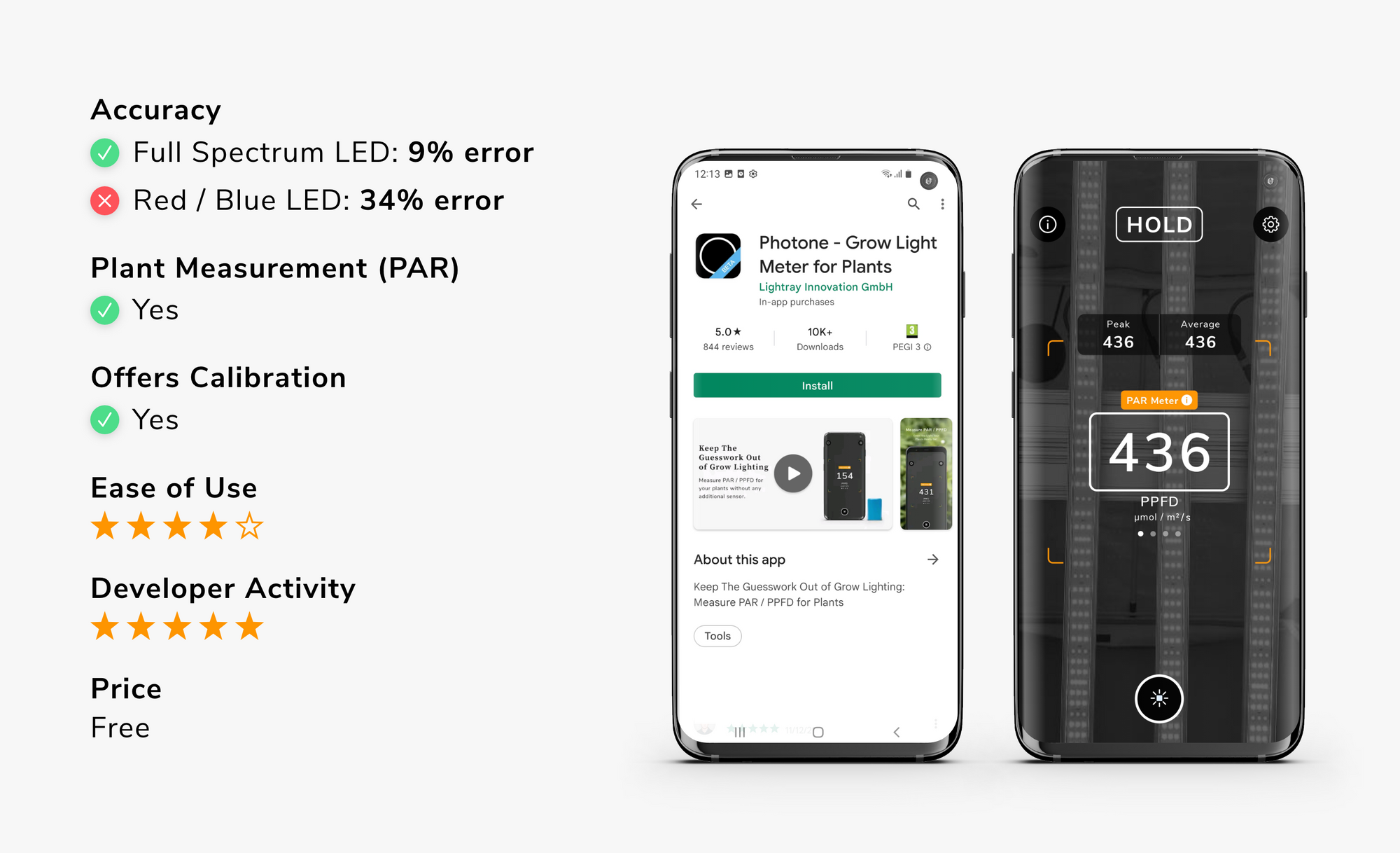
The Photone - Grow Light Meter for Plants is our own app and we don't want to advertise you anything without our full backing. Our Android version is still in its Beta phase and not as accurate as our iOS version on all of the 20'000 Android devices we're supporting, but also no less accurate than the other apps we've tested. The app also includes helpful guides and a calculator for cannabis, houseplants, and fruits and vegetables to assist you with your grow lighting decisions, giving you a further edge over using another app.
Recommended for Technicians: Tent Buddy
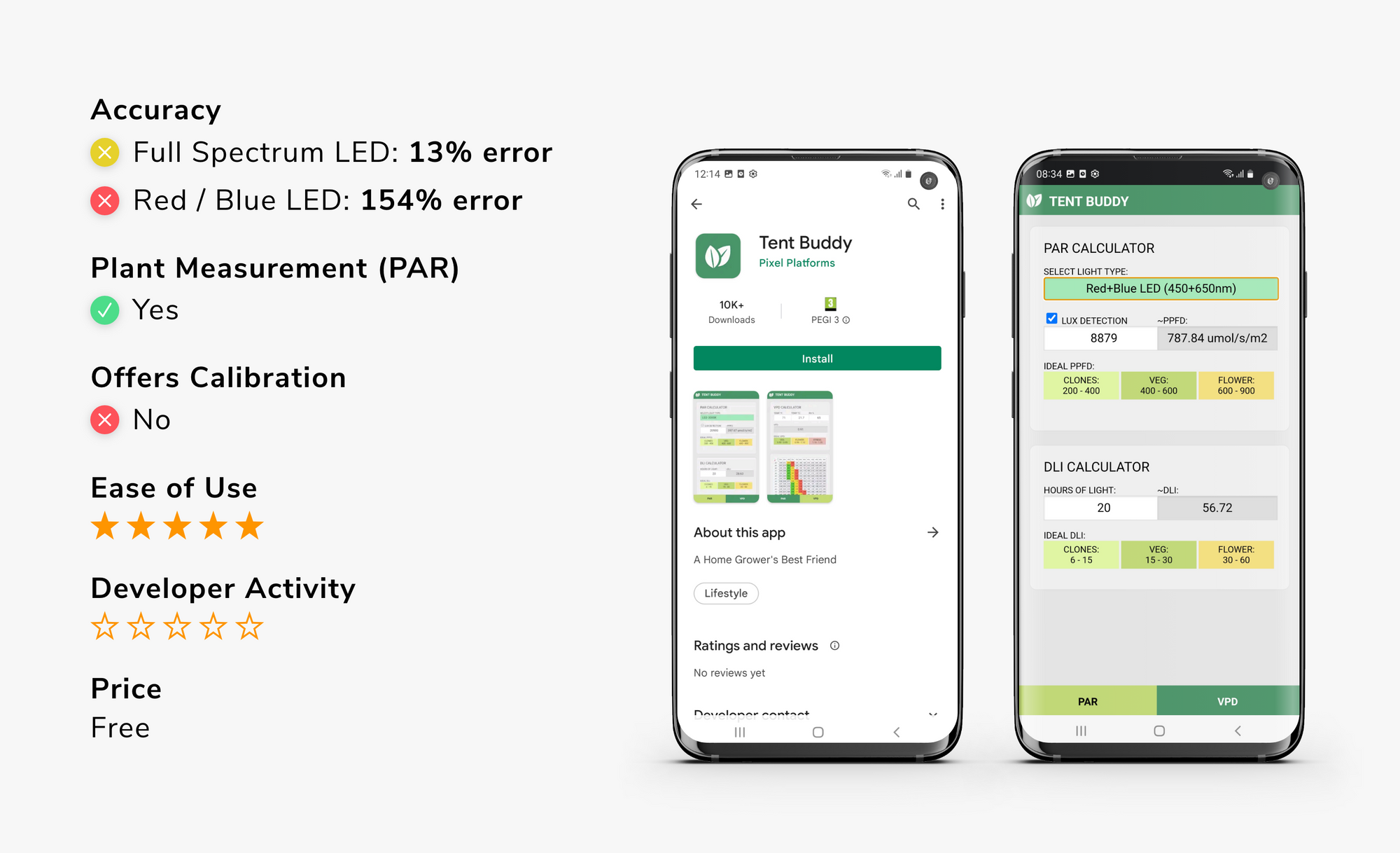
Tent Buddy is a fairly simple app for anyone that already understands the technical details of PAR, PPFD, and DLI and seems to be tailored to cannabis. The app is still in its version 1.0.0 since years and there is no developer activity so this can be an issue on the latest devices and Android versions. For most advanced growers, it includes what is needed and does a good job delivering it. Never use it to measure the PPFD of your red / blue LED equipped grow room as the error in our test was enormous!
Not Recommended: PPFD Meter - Grow Light Meter

The PPFD Meter app includes many features for the advanced indoor horticulturist and is regularly updated. This is great if, for instance, you want to create your own PAR map and know exactly what you do, but also increases the app's complexity which makes it a bit hard to configure. Still, the app offers all the features you need and can aid your grow lighting decisions. If you don't need all of those features, it can be viewed as a more complicated version of Tent Buddy ( including the same light settings) that also bombards you with advertising or wants to sell you on a subscription. Also, never use it to measure the PPFD of your red / blue LED equipped grow room as the error was enormous!
We also tested the PPFD Meter app with a Uni-T UT383 BT lux meter that can easily be integrated via Bluetooth and promises increased accuracy. However, this has not been the case in our tests: The Uni-T UT383 BT meter measured way higher than our reference lux meter and was especially worse at measuring red / blue LED lighting with an error of 221%! Using the Bluetooth meter didn't increase accuracy on our device but still offers some usability benefits that might come handy.
Not Recommended: Lux to PPFD Sensor

The Lux to PPFD Sensor app is very similar to the Tent Buddy app but supports less light sources. For instance, none of our LED lights was covered on the selection and we were forced to use the sunlight setting as the closest match. The app is still in its version 1.0.0 since years and there is no developer activity so this can be an issue on the latest devices and Android versions. We don't recommend to use it at all.
Not Recommended: Lux Light Meter Photometer PRO
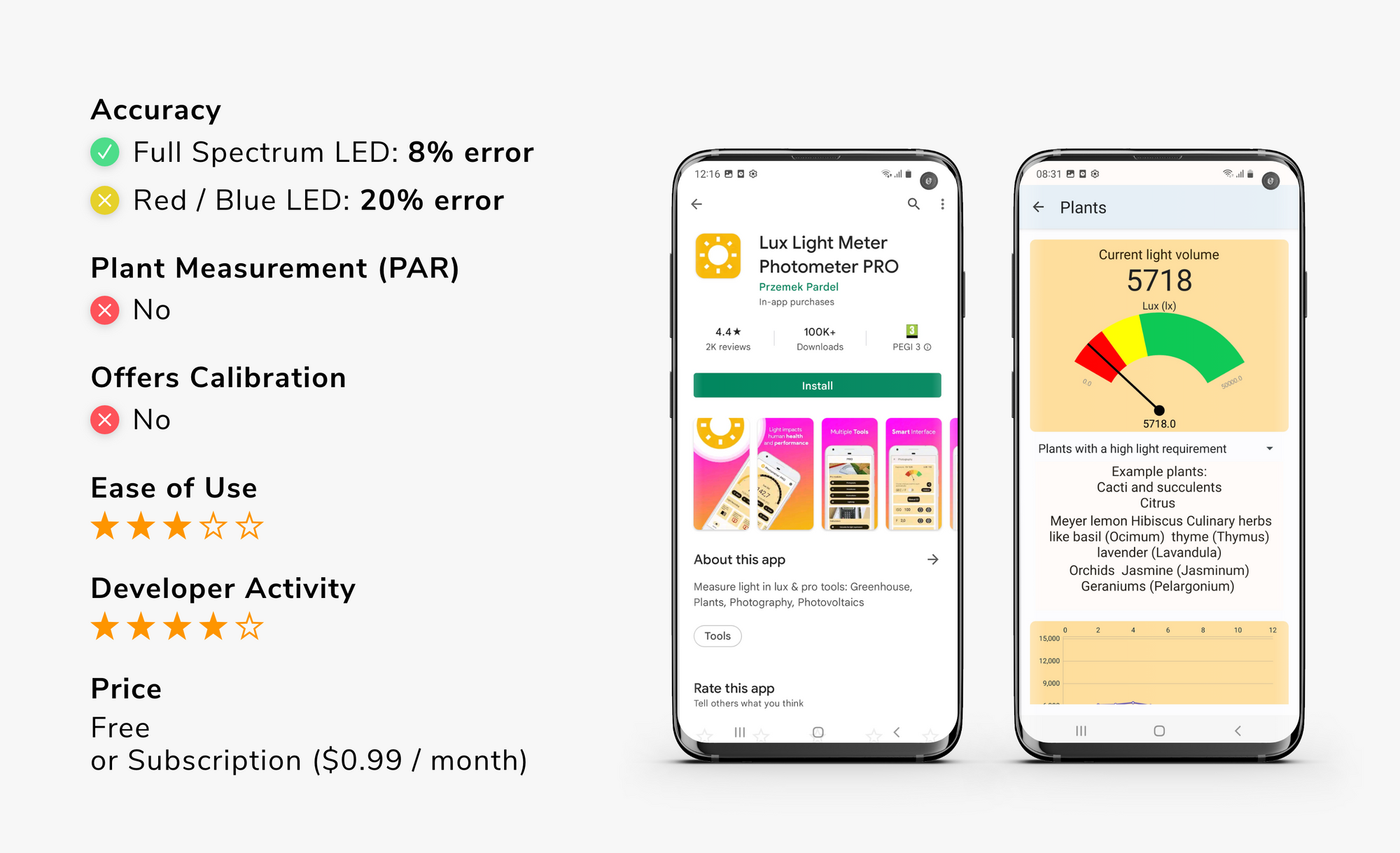
The Lux Light Meter Photometer PRO seems like the Swiss army knife of a light meter app including many modes and calculators – unfortunately, at the cost of usability. The developer makes a professional impression and updates the app frequently, which is a good sign. As there are better alternatives for plants, we don't recommend to use this app.
Not Recommended: Plant Light Meter
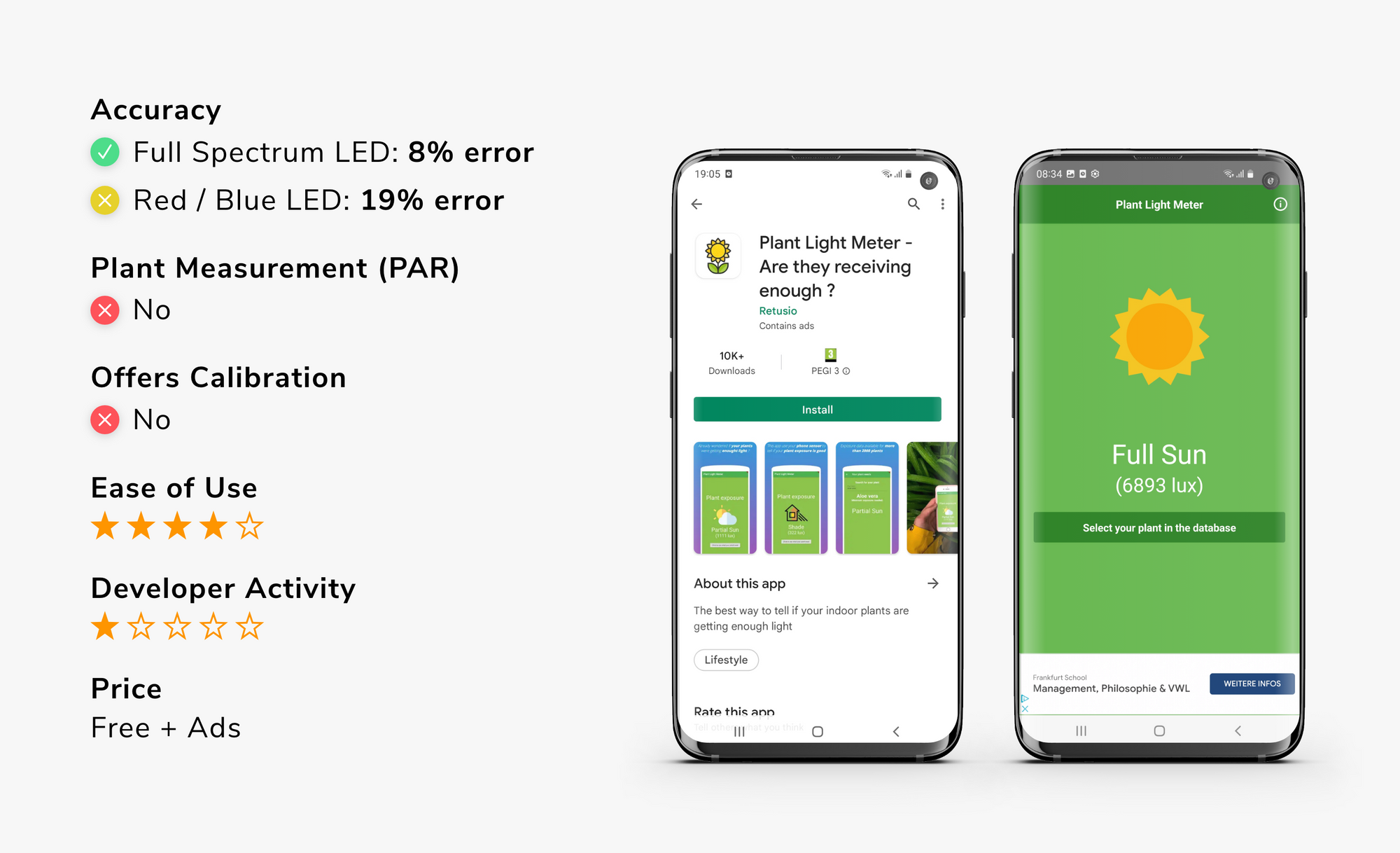
The Plant Light Meter app is a simple visualization of the ambient light sensor value and does a good job at delivering it easily alongside some advertising. The app is okay, but as there are better alternatives for plants, we don't recommend to use this app.
Not Recommended: HPJ Light Meter
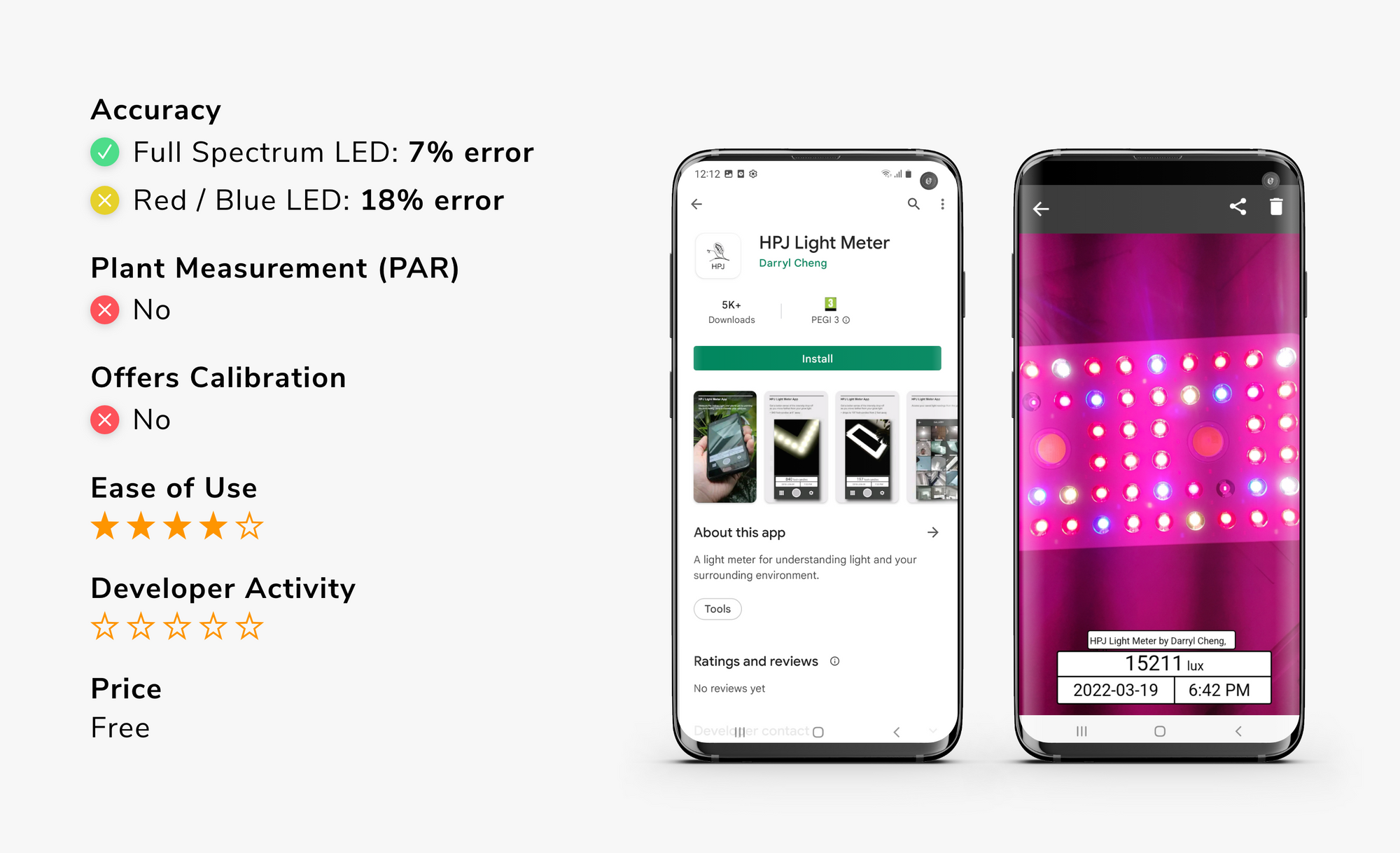
The HPJ Light Meter is a simple app that also includes the camera to see what your plant sees. What we like about this app is the option to take a picture of your measurement that then allows to compare your lighting over time. Unfortunately, it is another app that thas never been updated ever since. As the app only allows to measure illuminance, we don't recommend it for plant lighting decisions.
Detailed Measurement Results
Illuminance on iOS
We measured various light intensity levels using all light meters as described. The results are very interesting with large deviations between the different light meter apps as can be seen in the charts below:
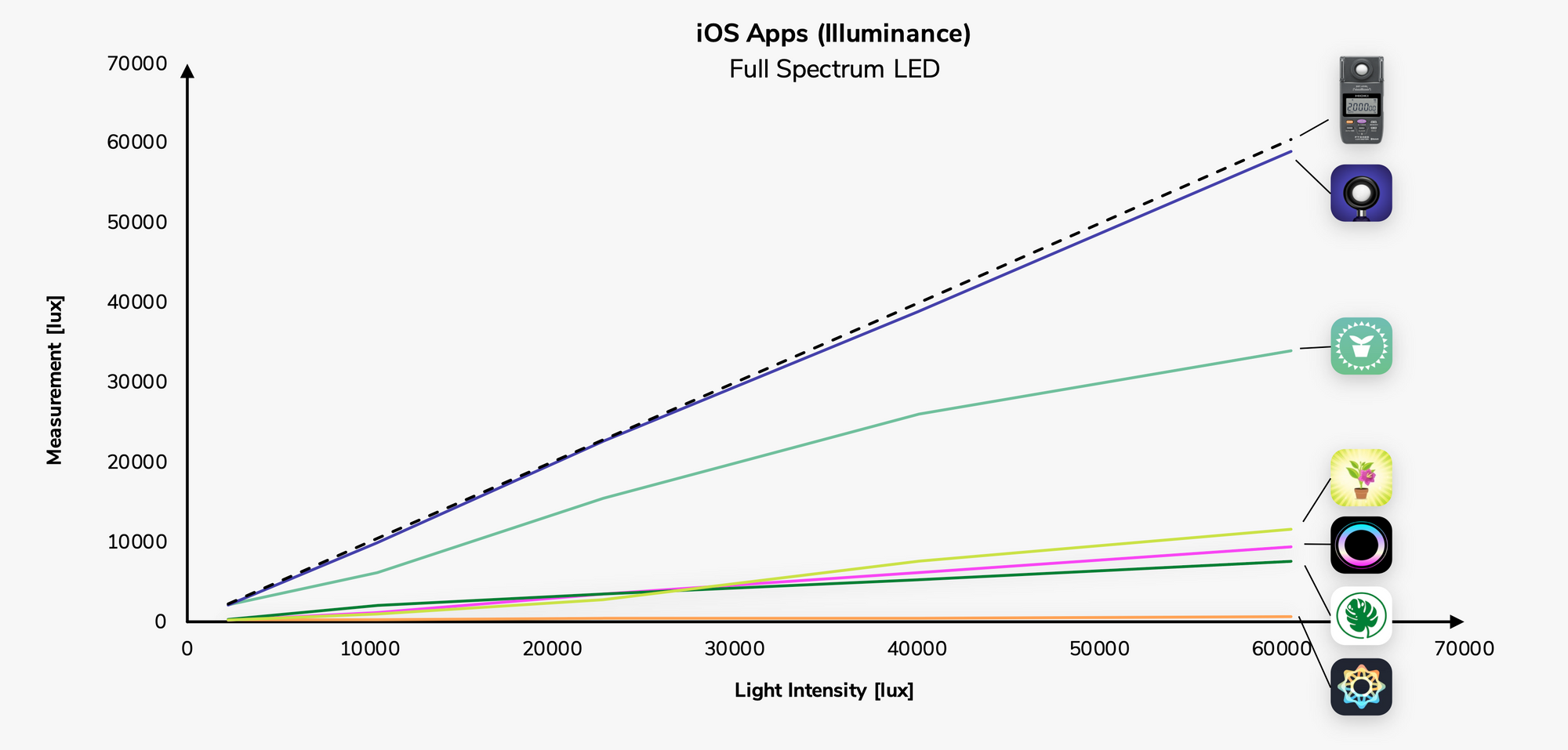
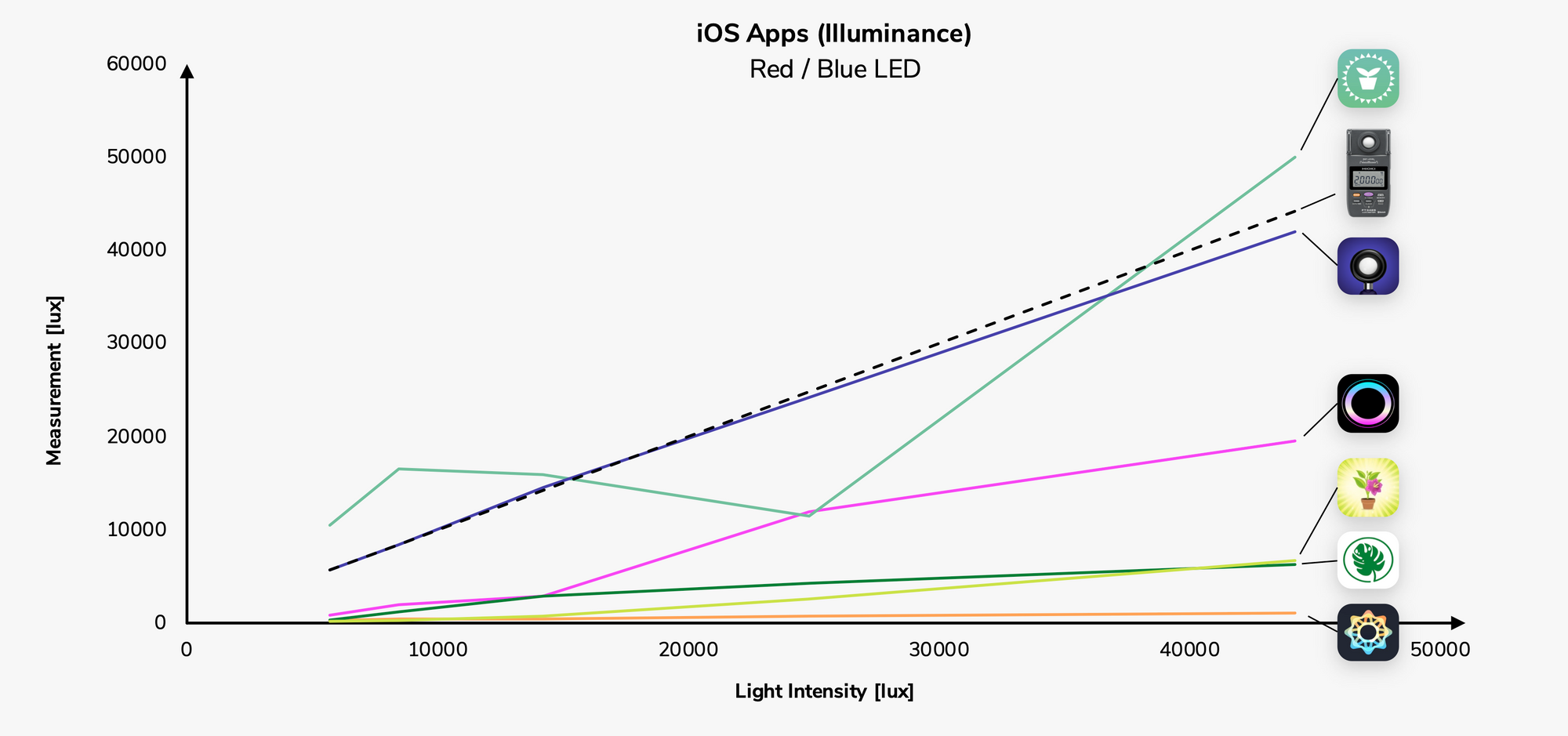
PAR / PPFD on iOS
As for the PAR / PPFD measurements, we again measured different light intensity levels using the Apogee quantum PAR sensor as the reference and Photone in its PAR meter configuration. The results can be seen in the charts below:
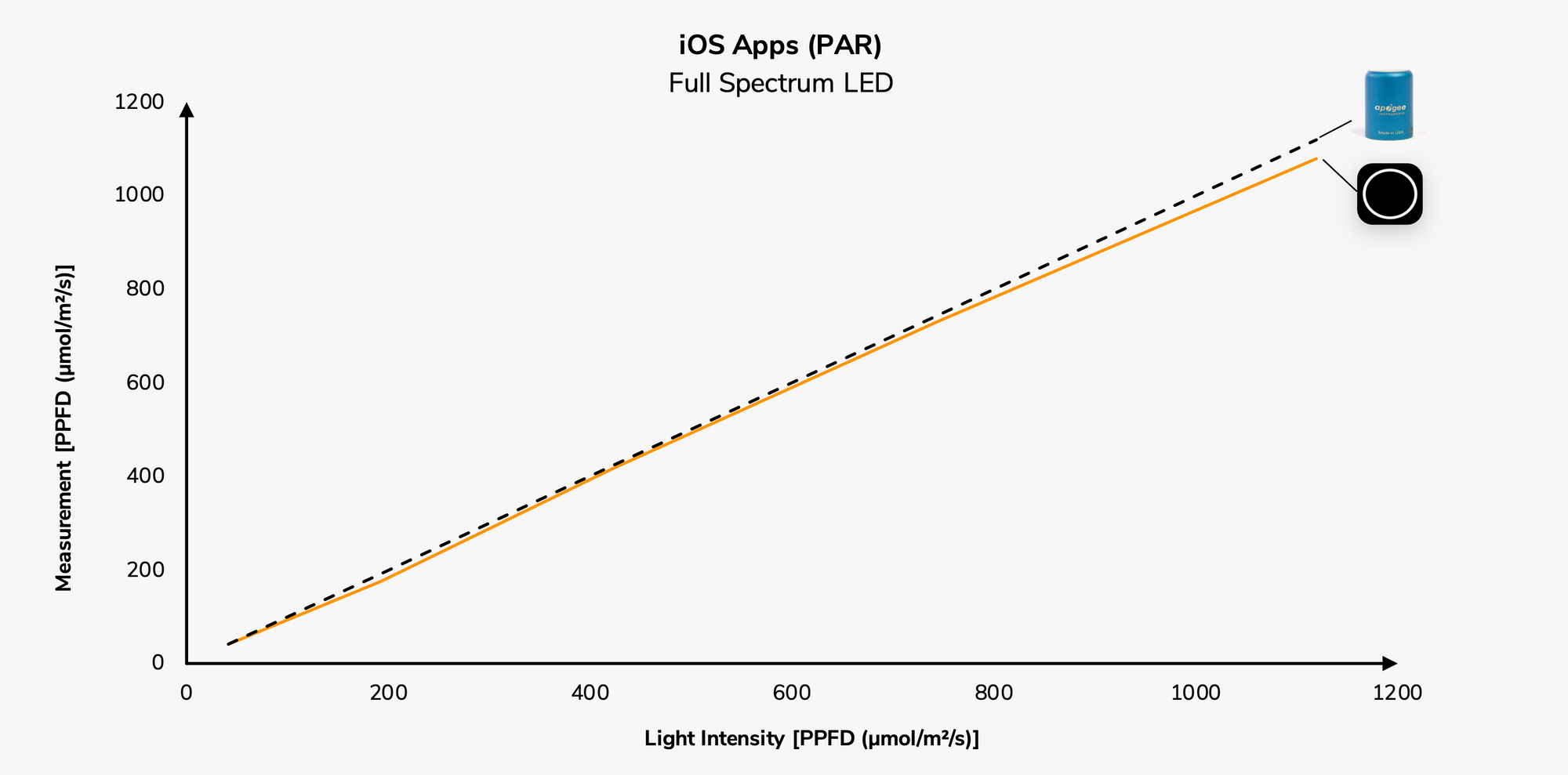
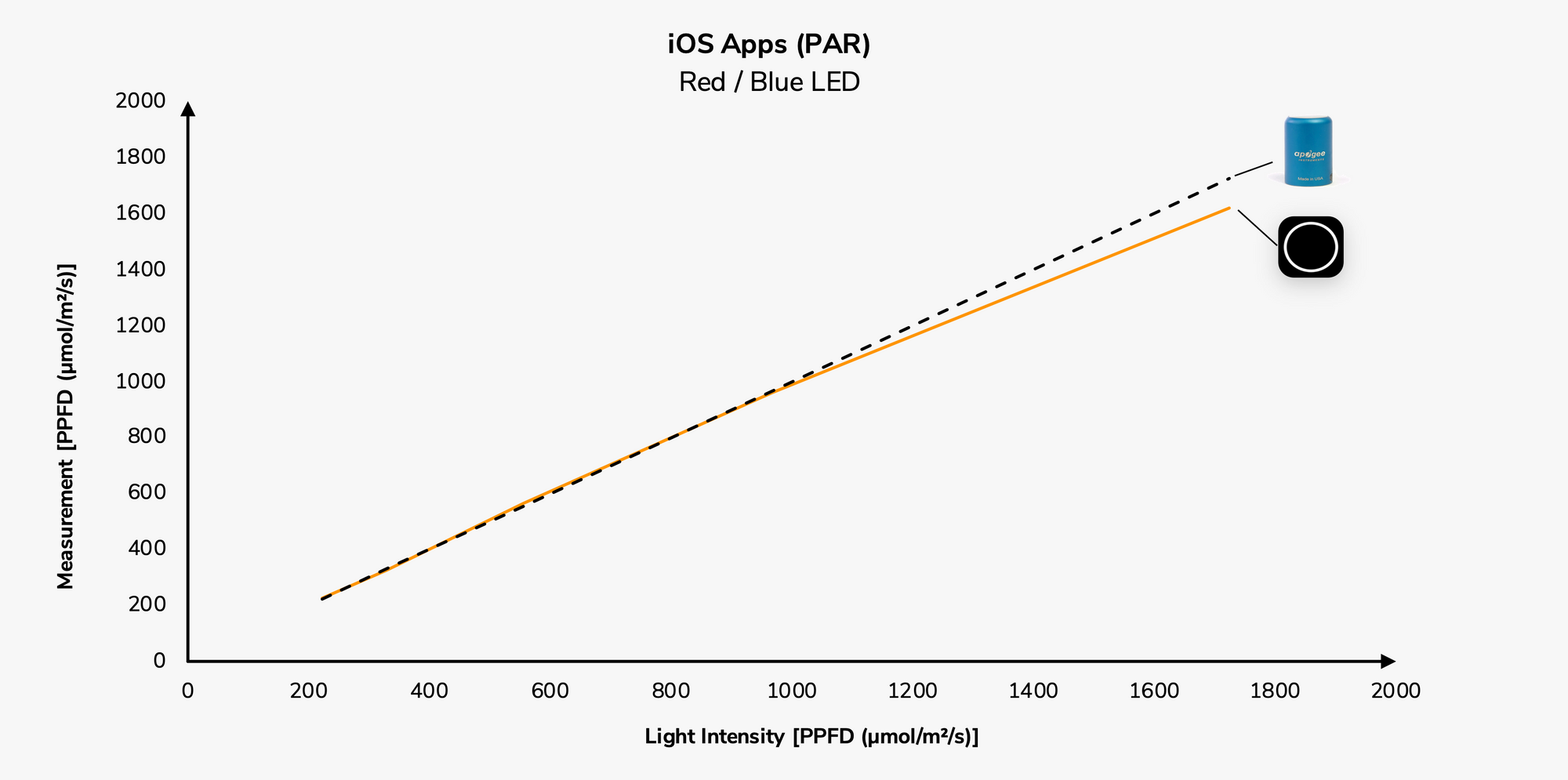
Illuminance on Android
We measured various light intensity levels using all light meter apps as described. All of the apps use the built in ambient light sensor, so it is no surprise that they measure the same.
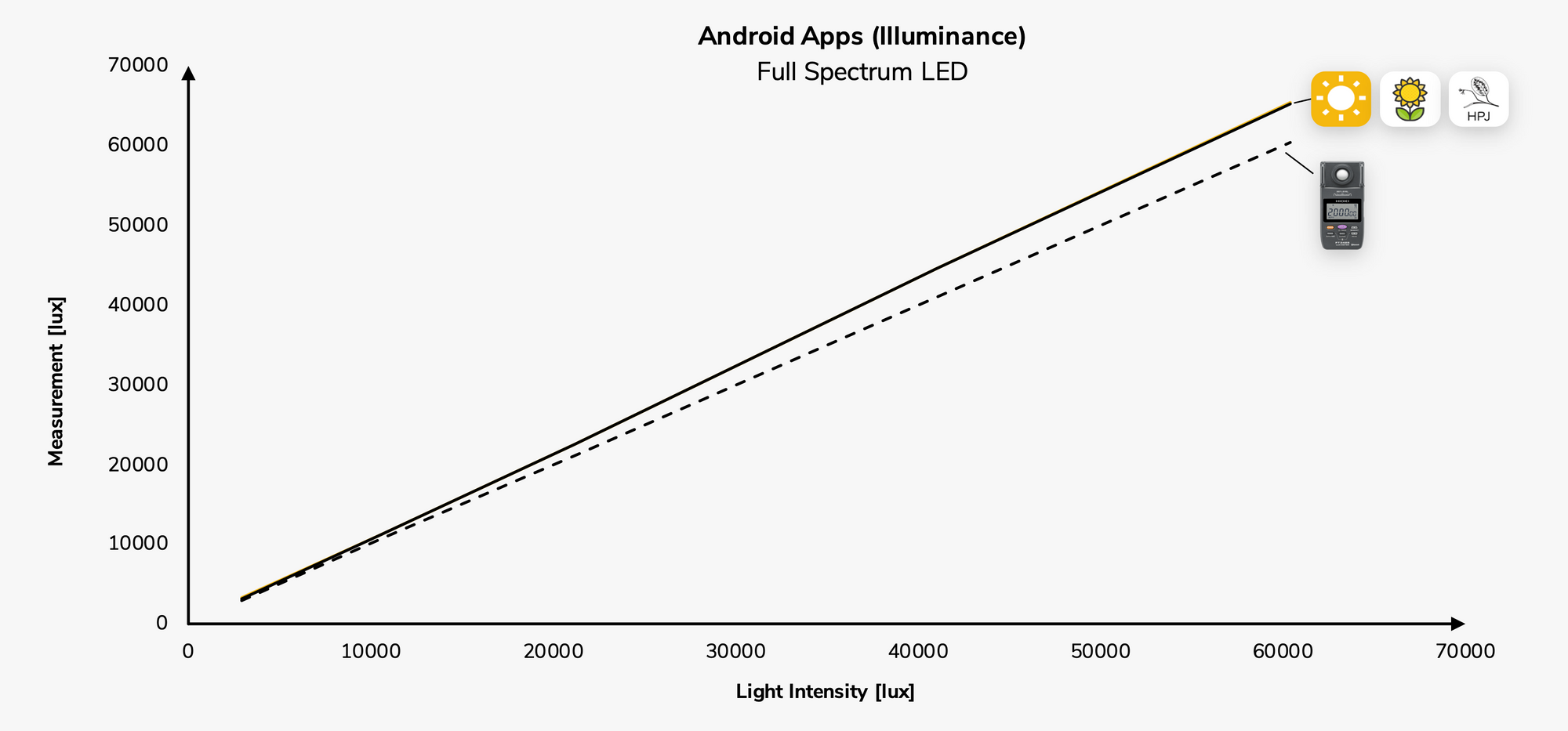
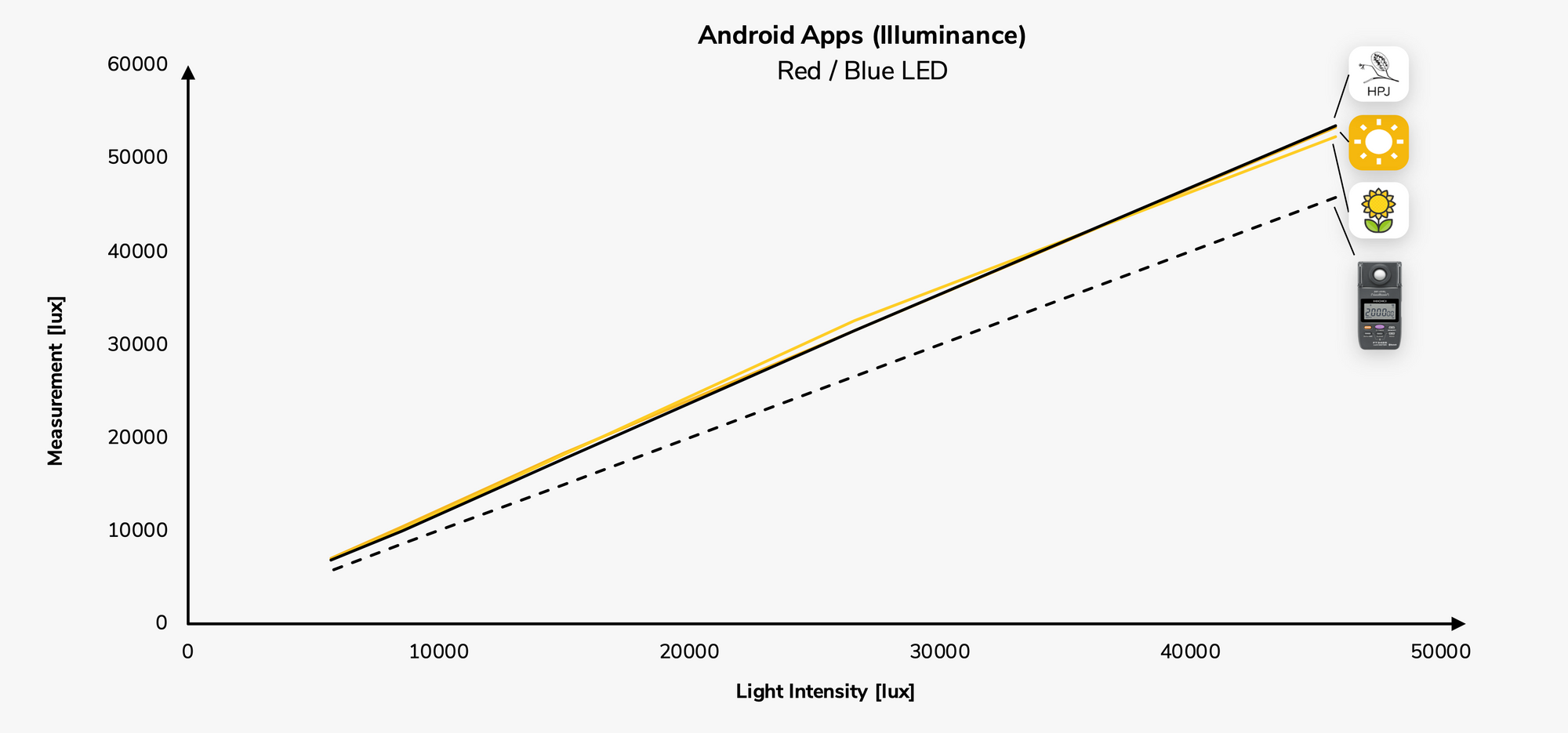
PAR / PPFD on Android
As for the PAR / PPFD measurements, we again measured different light intensity levels using the Apogee quantum PAR sensor as the reference and all apps as described. The errors on measuring red / blue LED light were enormous with the PPFD Meter and Tent Buddy apps whereas the full spectrum LED results were fairly close with all the apps. See for yourself:
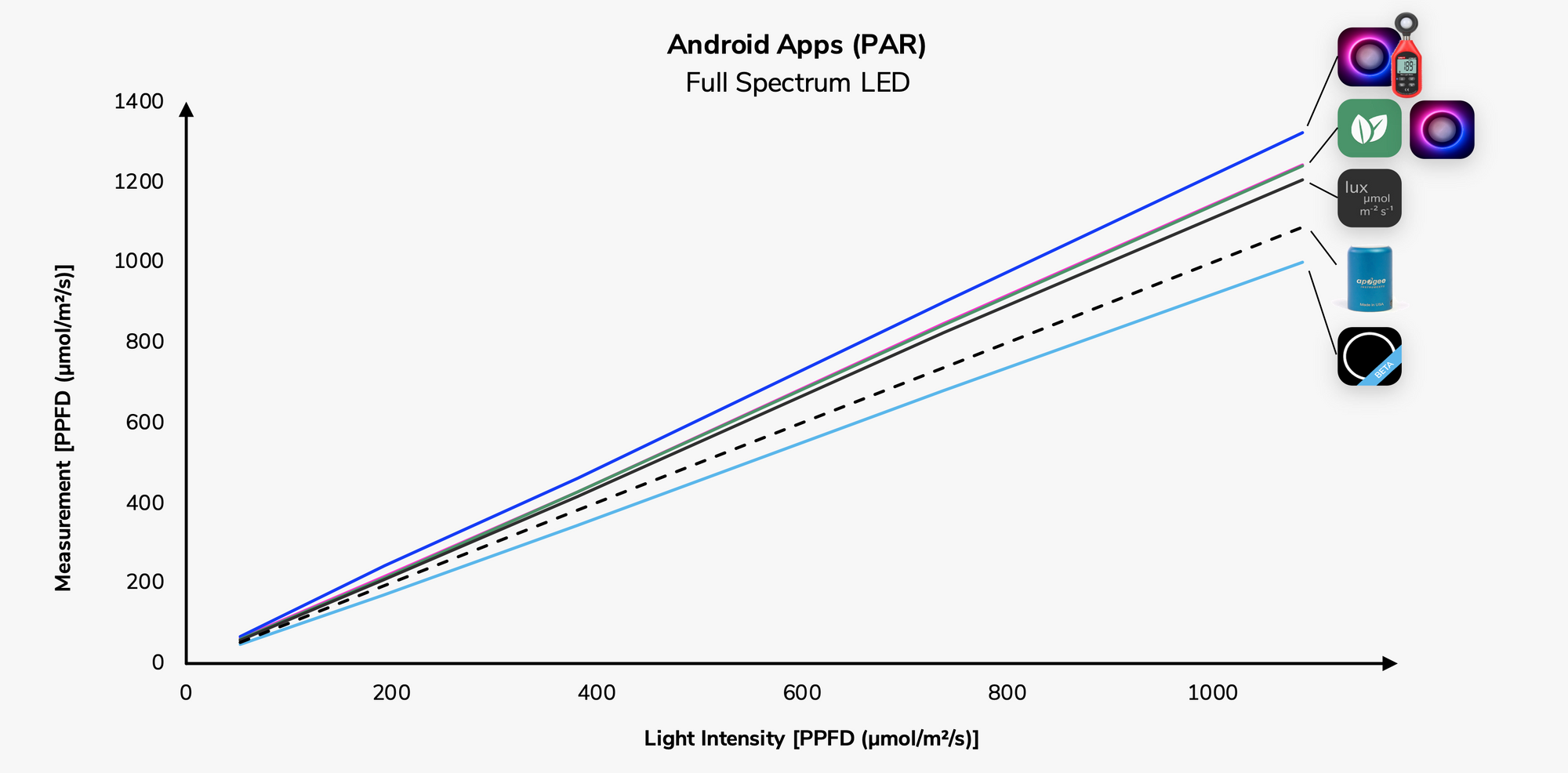
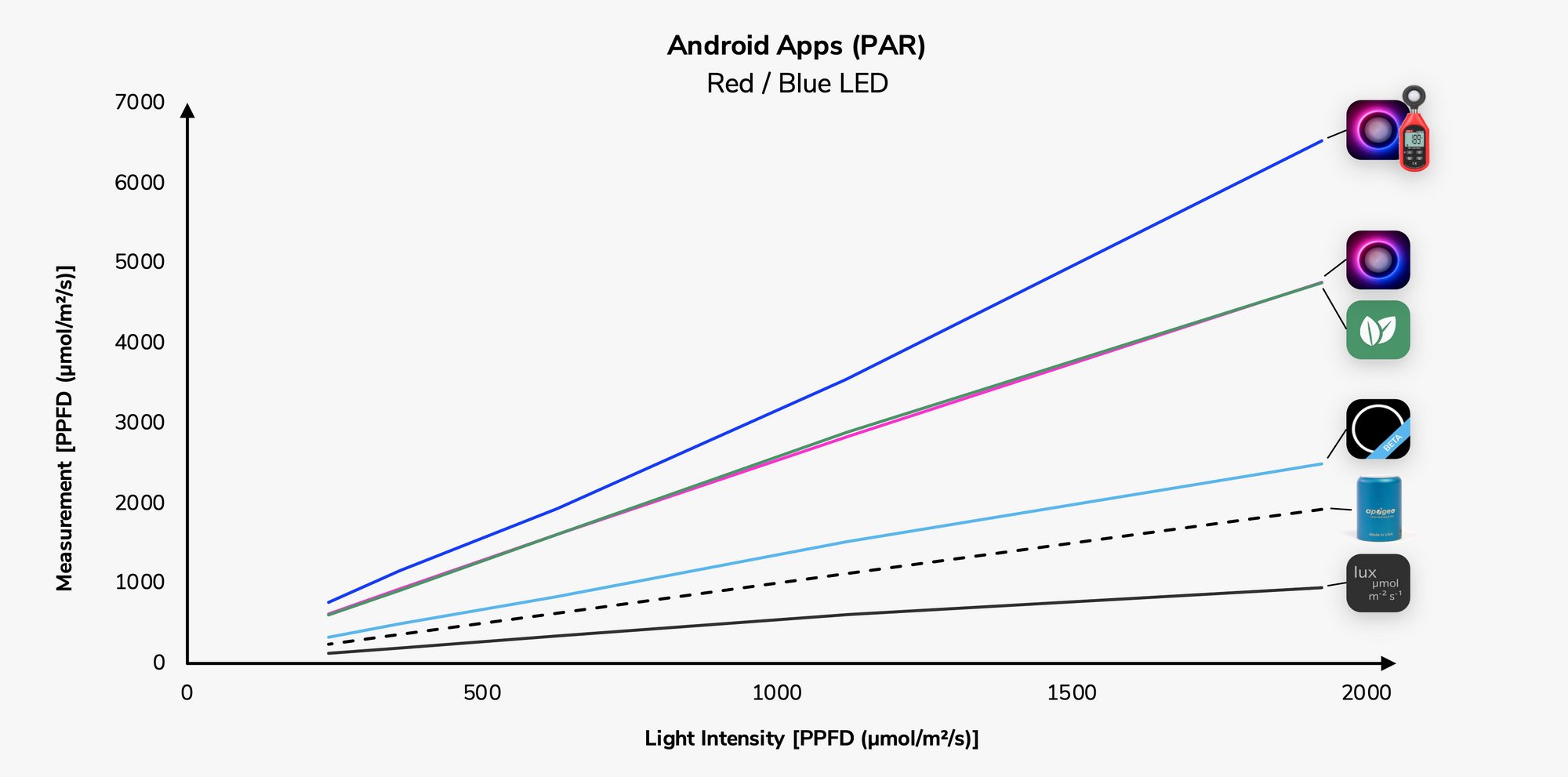
How We Tested
Lighting
We wanted to perform a test that is both accurate and representative for the usage in growing plants. We therefore used two of the most common grow lights: A full spectrum LED Quantum Board, that is used by many home- and professional growers alike, and a “blurple” Phlizon Red / Blue LED. We put each lamp fixture into a light proof grow box and varied the height to achieve different light intensity levels.
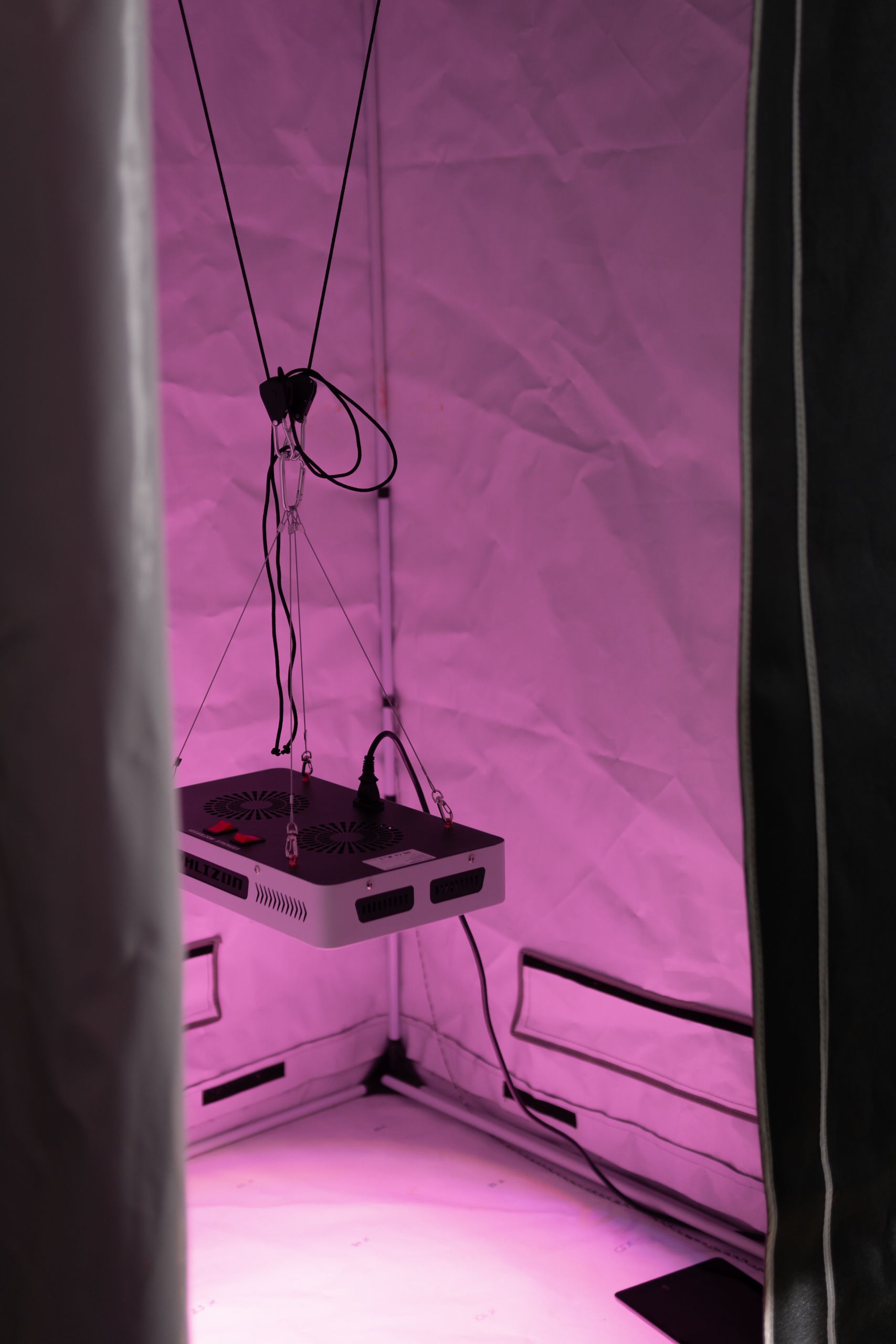
Reference Meters
The best in class reference meter we used throughout this comparison were a DIN 5032-7 class B and JIS 1609 class AA FT3425 lux meter made by HIOKI that is available at around $800. In order to measure PAR, we used our NIST traceable Apogee SQ-520 Full-Spectrum Smart Quantum Sensor costing around $500 as the reference.
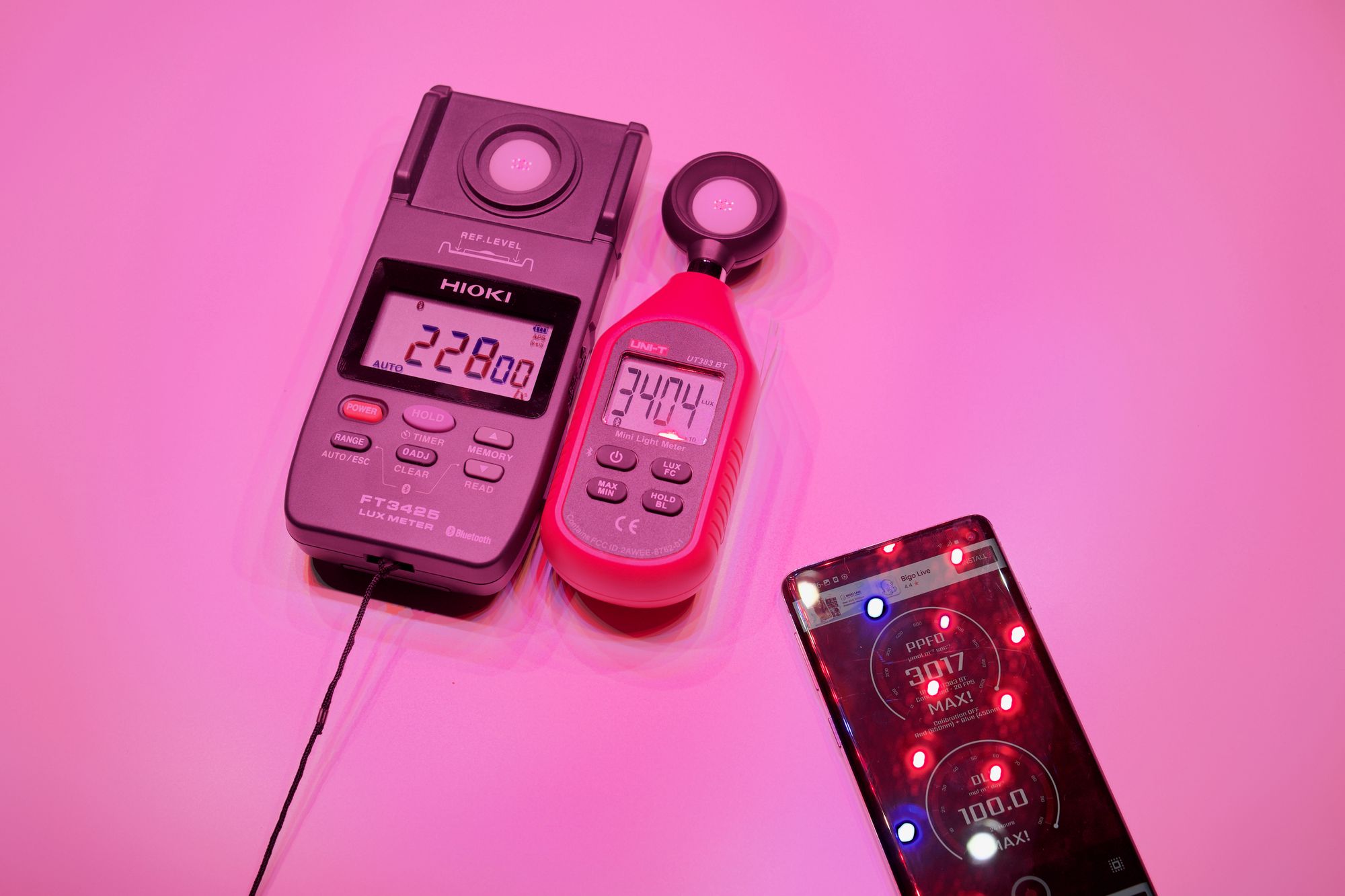
Phones
All iOS apps were tested on an iPhone 11 Pro running iOS 15 and with the most recent app version available as per March 2022. All Android apps were tested on a Samsung Galaxy S10 running Android 10 and also with the most recent app version available from Google Play.
Closing Thought
For us, this 2022 update has been an interesting test: Many apps claiming to do the same, yet they are completely different. We hope that this article is comprehensible and makes sense. If you have any inputs, please let us know!
If you think that our measurements are flawed: Please challenge us! Recreate a stable test setup and measure those apps against an accurate and reliable reference. We’d be pleased to see your results as well.
The measurements above provide us with absolute confidence that the Photone Grow Light Meter is an excellent alternative to any hardware PAR meter – especially at a $500 price difference!
Thank you for reading and happy growing!


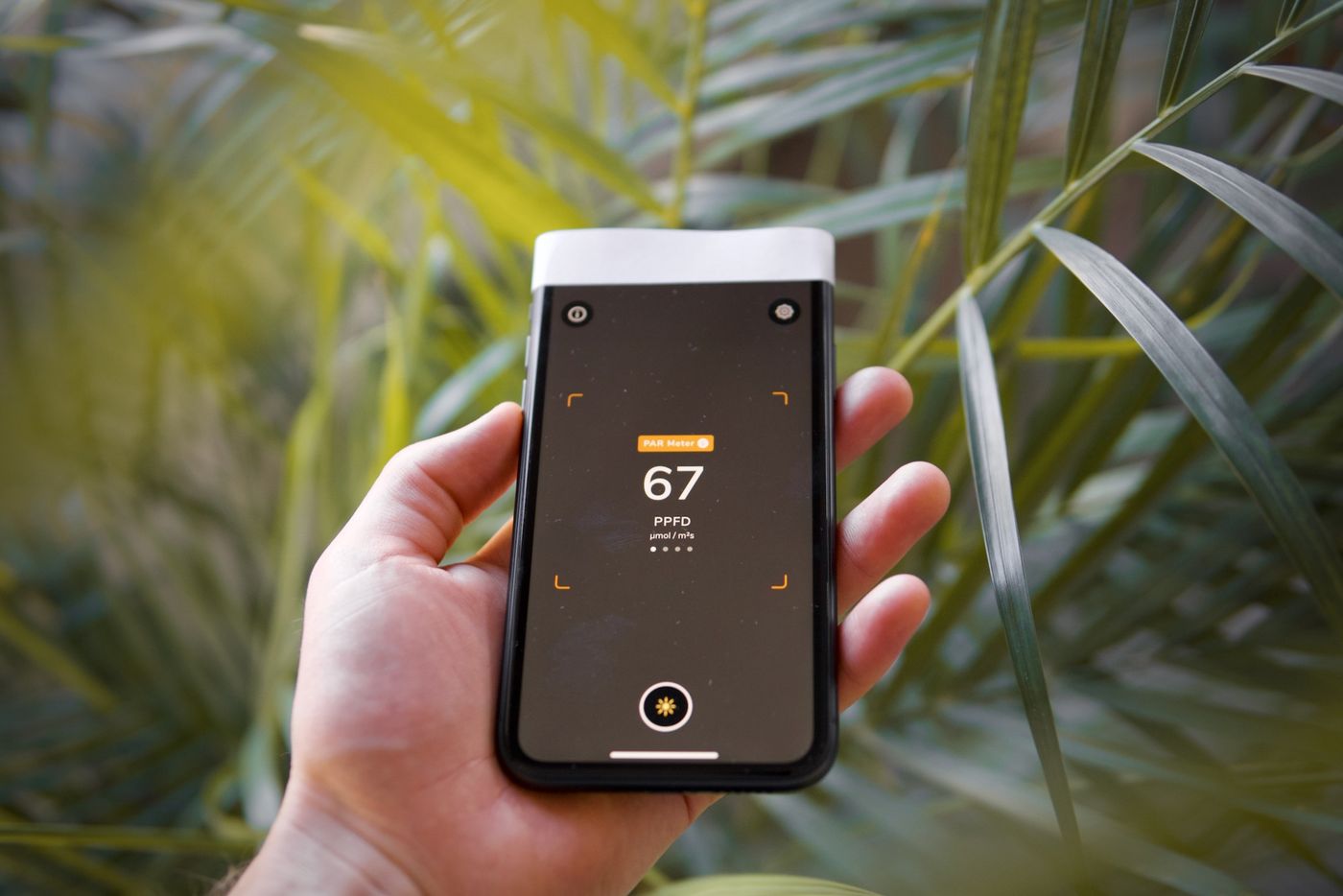
 Share This
Share This




